#it's really not common that i see names repeated- like in american films its common to run into 'bills' and 'toms' and that sort of thing
Text

still obsessed with how whenever you look up nakai you just get adachi front and center instead of arakawa or like. anyone he's actually played
#snap chats#im never mad about seeing adachi tho.... hello old man...#this isnt even to talk about the gorgeous cover picture they use for him. why the fuck is he on a horse looking like shakespeare#anyways i just got done watching a nakai movie- 'Hit Me Anyone One More Time'- i started a month back but forgot to resume#i was actually gonna post a cap from the movie since nakai was in a cute frilly apron and i was bouta make an arakawa joke#BUT let's just wait for me to draw it lbr LMAO#movie was cute if you were wondering... nakai plays as japan's prime minister Keisuke Kuroda who used to be a major dickwad#but after getting hit in the head with a rock he has a real Phineas Gage moment and does a whole 180#it was lowkey real cute cause like. kuroda's just Confused 70% of the time but he's also really earnest and trying to be good#and he loves his wife. a lot. i mean his wife hated him for most of the movie but its ok they're cute at the end#this movies cute. weird to say about a movie about a politician but its true#since im weening off my tsutsumi binge im legally allowed to say its funny how they both played men named keisuke#it's really not common that i see names repeated- like in american films its common to run into 'bills' and 'toms' and that sort of thing#but its rare that i see a name pop up more than once in jp media. i mean unless it's sega and 'makoto' then jesus fucking christ ENOUGH#THATS ENOUGH MAKOTOS#anyway im going to bed. bye
27 notes
·
View notes
Text
Chapter 4 – It is always 1895 [TAB 1/1]
TAB is my favourite episode of Sherlock. It is a masterpiece that investigates queerness, the canon and the psyche all within an hour and a half. Huge amounts of work has been done on this episode, however, so I’m not going to do a line by line breakdown – that could fill a small book. A great starting point for understanding the myriad of references in TAB is Rebekah’s three part video series on the episode, of which the first instalment can be found here X. I broadly agree with this analysis; what I’m going to do here, though, is place that analysis within the framework of EMP theory. As a result, as much as it pains me, this chapter won’t give a breakdown of carnation wallpaper or glass houses or any of those quietly woven references – we’re simply going in to how it plays into EMP theory.
Before digging into the episode, I want to take a brief diversion to talk about one of my favourite films, Mulholland Drive (2001).

If you haven’t seen Mulholland Drive, I really recommend it – it’s often cited as the best film of the last 20 years, and watching it really helps to see where TAB came from and the genre it’s operating in. David Lynch is one of the only directors to do the dream-exploration-of-the-psyche well, and I maintain that a lot of the fuckiness in the fourth series draws on Lynch. However, what I actually want to point out about Mulholland Drive is the structure of it, because I think it will help us understand TAB a little better. [If you don’t want spoilers for Mulholland Drive, skip the next paragraph.]
The similarities between these two are pretty straightforward; the most common reading of Mulholland Drive is that an actress commits suicide by overdose after causing the death of her ex-girlfriend, who has left her for a man, and that the first two-thirds of the film are her dream of an alternate scenario in which her girlfriend is saved. The last third of the film zooms in and out of ‘real life’, but at the end we see a surreal version of the actual overdose which suggests that this ‘real life’, too, has just been in her psyche. Sherlock dying and recognising that this may kill John is an integral part of TAB, and the relationships have clear parallels, but what is most interesting here is the structural similarity; two-thirds of the way through TAB, give or take, we have the jolt into reality, zoom in and out of it for a while and then have a fucky scene to finish with that suggests that everything is, in fact, still in our dying protagonist’s brain. Mulholland Drive’s ending is a lot sadder than TAB’s – the fact that, unlike Sherlock, there is no sequel can lead us to assume that Diane dies – and it’s also a lot more confusing; it’s often cited as one of the most complicated films ever made even just in terms of surface level plot, before getting into anything else, and it certainly took me a huge amount of time on Google before I could approach anything like a resolution on it!
Mulholland Drive is the defining film in terms of the navigating-the-surreal-psyche subgenre, and so the structural parallels between the two are significant – and definitely point to the idea that Sherlock hasn’t woken up at the end of TAB, which is important. But we don’t need to take this parallel as evidence; there’s plenty of that in the episode itself. Let’s jump in.
Emelia as Eurus

When we first meet Eurus in TST, she calls herself E; this initialism is a link to Moriarty, but it’s also a convenient link to other ‘E’ names. Lots of people have already commented on the aural echo of ‘Eros’ in ‘Eurus’, which is undeniable; the idea that there is something sexual hidden inside her name chimes beautifully with her representation of a sexual repression. The other important character to begin with E, however, is Emelia Ricoletti. The name ‘Emelia’ doesn’t come from ACD canon, and it’s an unorthodox spelling (Amelia would be far more common), suggesting that starting with an ‘E’ is a considered choice.
When TAB aired, we were preoccupied with Emelia as a Sherlock mirror, and it’s easy to see why; the visual parallels (curly black hair, pale skin) plus the parallel faked death down to the replacement body, which Mofftiss explicitly acknowledge in the episode. However, I don’t think that this reading is complete; rather, she foreshadows the Eurus that we meet in s4. The theme of ghosts links TAB with s4 very cleanly; TAB is about Emelia, but there is also a suggestion of the ghosts of one’s past with Sir Eustace as well as Sherlock’s own claims (‘the shadows that define our every sunny day’). Compare this to s4 – ‘ghosts from the past’ appears on pretty much every promotional blurb, and the word is used several times in relation to Eurus. If Eurus is the ghost from Sherlock’s past, the repressive part of his psyche that keeps popping back, Emelia is a lovely metaphor for this; she is quite literally the ghost version of Sherlock who won’t die.

What does it mean, then, when Jim and Emelia become one and the same in the scene where Jim wears the bride’s dress? We initially read this as Jim being the foil to Sherlock, his dark side, but I think it’s more complicated than this. Sherlock’s brain is using Emelia as a means of understanding Jim, but when we watch the episode it seems that they’ve actually merged. Jim wearing the veil of the bride is a good example of this, but I also invite you to rewatch the moment when John is spooked by the bride the night that Eustace dies; the do not forget me song has an undeniable South Dublin accent.* This is quite possibly Yasmine Akram [Janine] rather than Andrew Scott, of course, but let’s not forget that these characters are resolutely similar, and hearing Jim’s accent in a genderless whisper is a pretty clear way of inflecting him into the image of the bride. In addition to this, Eustace then has ‘Miss Me?’ written on his corpse, cementing the link to Moriarty.
[*the South Dublin accent is my accent, so although we hear a half-whispered song for all of five seconds, I’m pretty certain about this]
Jim’s merging with Emelia calls to mind for me what I think might be the most important visual of all of series 4 – Eurus and Jim’s Christmas meeting, where they dance in circles with the glass between them and seem to merge into each other. I do talk about this in a later chapter, but TLDR – if Jim represents John being in danger and Eurus represents decades of repressed gay trauma, this merging is what draws the trauma to the surface just as Jim’s help is what suddenly makes Eurus a problem. It is John’s being in danger which makes Sherlock’s trauma suddenly spike and rise – he has to confront this for the first time – just like Emelia Ricoletti’s case from 1895 only needs solving for the first time now that Jim is back.
At some point I want to do a drag in Sherlock meta, because I think there’s a lot more to it than meets the eye, but Jim in a bride’s dress does draw one obvious drag parallel for me.

If you haven’t seen the music video for I Want to Break Free, it’s 3 minutes long and glorious – and also, I think, reaps dividends when seen in terms of Sherlock. You can watch it here: X
Not only is it a great video, but for British people of Mofftiss’s age, it’s culturally iconic and not something that would be forgotten when choosing that song for Jim. Queen were intending to lampoon Coronation Street, a British soap, and already on the wrong side of America for Freddie Mercury’s unapologetic queerness, found themselves under fire from the American censors. Brian May says that no matter how many times he tried to explain Coronation Street to the Americans, they just didn’t get it. This was huge controversy at the time, but the video and the controversy around it also managed to cement I Want to Break Free as Queen’s most iconic queer number – despite not even being one of Mercury’s songs. There is no way that Steven Moffat, and even more so Mark Gatiss would not have an awareness of this in choosing this song for Moriarty. Applying any visual to this song is going to invite comparisons to the video – and inflecting a sense of drag here is far from inappropriate. Moriarty has been subsumed into Eurus in Sherlock’s brain – the male and the female are fused into an androgynous and implicitly therefore all-encompassing being. I’m not necessarily comfortable with the gendered aspect of this – genderbending is something we really only see in our villains here – but given this is about queer trauma, deliberately queering its form in this way is making what we’re seeing much more explicit.
Nothing new under the sun
“The thing that hath been, it is that which shall be; and that which is done is that which shall be done: and there is no new thing under the sun” (Ecclesiastes)
"Read it up -- you really should. There is nothing new under the sun. It has all been done before." (A Study in Scarlet, Sherlock Holmes)
“Hasn’t this all happened before? There’s nothing new under the sun.” (The Abominable Bride, Jim Moriarty)
This is arguably the key to spotting that TAB is a dream long before they tell us – when TAB’s case is early revealed to be a mixture between TRF (Emelia’s suicide) and TGG (the five pips), and we see the opening of ASiP repeated, we should be questioning what on earth is going on. This can also help us to recognise s4 as being EMP as well though – old motifs from the previous series keep repeating through the cases, like alarm bells ringing. Moriarty telling Sherlock that there is nothing new under the sun is his key to understanding that the Emelia case is meant to help him understand what happened to Jim, that it’s a mental allegory or mirror to help him parse it. This doesn’t go away when TAB ends! Moving into TST, one of the striking things is that cases are still repeating! The Six Thatchers appeared on John’s blog way back, before the fall – you can read it here: X. It’s about a gay love affair that ends in one participant killing the other. Take from that what you will, when John’s extramarital affection is making him suicidal and Sherlock comatose. Meanwhile, the title of The Final Problem refers to the story that was already covered in TRF and the phone situation with the girl on the plane references both ASiB and TGG, and the ending of TST is close to a rerun of HLV. It’s pretty much impossible to escape echoes of previous series in a way that is almost creepy, but we’ve already had this explained to us in TAB – none of this is real. It’s supposed to be explaining what is happening in the real world – and Mofftiss realised that this was going to be difficult to stomach, and so they included TAB as a kind of key to the rest of the EMP, which becomes much more complex.
However, if we want to go deeper we should look at where that quote comes from. I’ve given a few epigraphs to this section to show where the quote comes from – first the book of Ecclesiastes, then A Study in Scarlet. It’s one of the first things Holmes says and it is during his first deduction in Lauriston Gardens. This is where I’m going to dive pretty deep into the metatextual side of things, so bear with the weirdness.
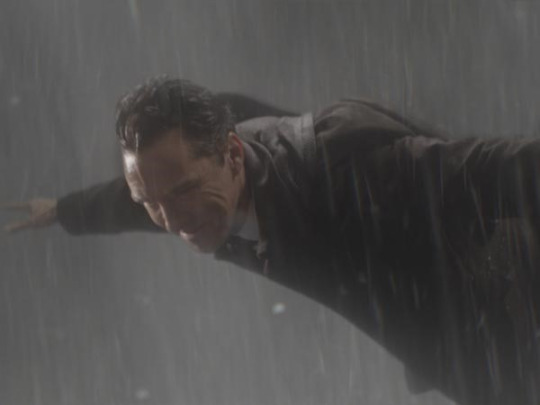
[we’re going deeper]
Holmes’s first deduction from A Study in Scarlet shows that he’s no great innovator – he simply notices things and spots patterns from things he has seen before. This is highlighted by the fact that he even makes this claim by quoting someone before him. If our Sherlock also makes deductions based on patterns from the past, extensive dream sequences where he works through past cases as mirrors for present ones makes perfect sense and draws very cleverly on canon. However, I think his spotting of patterns goes deeper than that. Sherlock Holmes has been repressed since the publication of A Study in Scarlet, through countless adaptations in literature and film. Plenty of these adaptations as well as the original stories are referenced in the EMP, not least by going back to 1895, the year that symbolises the era in which most of these adaptations are set. (If you don’t already know it, check out the poem 221B by Vincent Starrett, one of the myriad of reasons why the year 1895 is so significant.) My feeling is that these adaptations, which have layered on top of each other in the public consciousness to cement the image of Sherlock Holmes the deductive machine [which he’s not, sorry Conan Doyle estate] come to symbolise the 100+ years of repression that Sherlock himself has to fight through to come out of the EMP as his queer self.
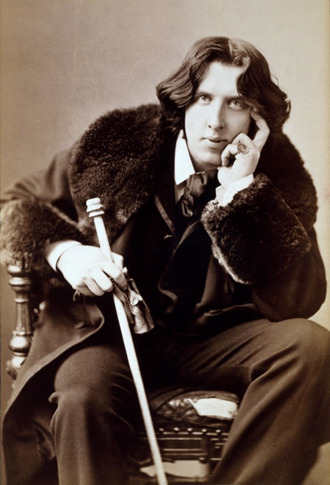
This is one of the reasons that the year 1895 is so important; it was the year of Oscar Wilde’s trial and imprisonment for gross indecency, and this is clearly a preoccupation of Sherlock’s consciousness in TFP with its constant Wilde references, suggesting that his MP’s choice of 1895 wasn’t coincidental. Much was made during TAB setlock of a newspaper that said ‘Heimish The Ideal Husband’, Hamish being John’s middle name and An Ideal Husband being one of Wilde’s plays. But the Vincent Starrett poem, although nostalgic and ostensibly lovely, for tjlcers and it seems for Sherlock himself symbolises something much more troubling. Do search up the full poem, but for now let’s look at the final couplet.
Here, though the world explode, these two survive
And it is always 1895
‘Though the world explode’ is a reference to WW1, which is coming in the final Sherlock Holmes story, and which is symbolised by Eurus – in other chapters, I explain why Eurus and WW1 are united under the concept of ‘winds of change’ in this show. Sherlock and John survive the winds of change – except they don’t move with them. Instead, they stay stuck in 1895, the year of ultimate repression. 2014!Sherlock going back in his head to 1895 and repeating how he met John suggests exactly that, that nothing has changed but the superficial, and that emotionally, he is still stuck in 1895.
Others have pulled out similar references to Holmes adaptations he has to push through in TAB – look at the way he talks in sign language to Wilder, which can only be a reference to Billy Wilder, director of TPLoSH, the only queer Holmes film, and a film which was forced to speak through coding because of the Conan Doyle estate. That film is also referenced by Eurus giving Sherlock a Stradivarius, which is a gift given to him in TPLoSH in exchange for feigning heterosexuality. Eurus is coded as Sherlock’s repression, and citing a repressive moment in a queer film as her first action when she meets Sherlock is another engagement by Sherlock’s psyche with his own cinematic history. My favourite metatextual moment of this nature, however, is the final scene of TFP which sees John and Sherlock running out of a building called Rathbone Place.

Basil Rathbone is one of the most iconic Sherlock Holmes actors on film, and Benedict’s costume in TAB and in particular the big overcoat look are very reminiscent of Rathbone.


Others have discussed (X) how the Victorian costume and the continued use of the deerstalker in the present day are images of Sherlock’s public façade and exclusion of queerness from his identity. It’s true that pretty much every Holmes adaptation has used the deerstalker, but the strong Rathbone vibes that come from Ben’s TAB costume ties the 1895 vibe very strongly into Rathbone. To have the final scene – and hopefully exit from the EMP – tie in with Sherlock and John running out of Rathbone Place tells us that, just as Sherlock cast off the deerstalker at the end of TAB (!), he has also cast off the iconic filmic Holmes persona which has never been true to his actual identity.
Waterfall scene
The symbol of water runs through TAB as well as s4 – others have written fantastic meta on why water represents Sherlock’s subconscious (X), but I want to give a brief outline. It first appears with the word ‘deeper’ which keeps reappearing, which then reaches a climax in the waterfall scene. The idea that Sherlock could drown in the waters of his mind is something that Moriarty explicitly references, suggesting that Sherlock could be ‘buried in his own Mind Palace’. The ‘deep waters’ line keeps repeating through series 4, and I just want to give the notorious promo photo from s4 which confirms the significance of the motif.

This is purely symbolic – it never happens in the show. Water increases in significance throughout – think of Sherlock thinking he’s going mad in his mind as he is suspended over the Thames, or the utterly nonsensical placement of Sherrinford in the middle of the ocean – the deepest waters of Sherlock’s mind. Much like the repetition of cases hinting that EMP continues, the use of water is something that appears in the MP, and it sticks around from TAB onwards, a real sign that we’re going deeper and deeper. I talk about this more in the bit on TFP, but the good news is that Sherrinford is the most remote place they could find in the ocean – that’s the deepest we’re going. After that, we’re coming out (of the mind).
Shortly after TAB aired, I wrote a meta about the waterfall scene, some of which I now disagree with, but the core framework still stands – it did not, of course, bank on EMP theory. You can find it here (X), but I want to reiterate the basic framework, because it still makes a lot of sense. Jim represents the fear of John’s suicide, and Jim can only be defeated by Sherlock and John together, not one alone – and crucially, calling each other by first names, which would have been very intimate in the Victorian era. After Jim is “killed”, we have Sherlock’s fall. The concept of a fall (as in IOU a fall) has long been linked with falling in love in tjlc. Sherlock tells John that it’s not the fall that kills you, it’s the landing, something that Jim has been suggesting to him for a while. What is the landing, then? Well, Sherlock Holmes fell in love back in the Victorian era, symbolised by the ultra repressive 1895, and that’s where he jumps from – but he lands in the 21st century. Falling in love won’t kill him in the modern day. What I missed that time around, of course, was that despite breaking through the initial Victorian layers of repression, he still dives into more water, and when the plane lands, it still lands in his MP, just in a mental state where the punishment his psyche deals him for homosexuality is less severe. This also sets up s4 as specifically dealing with the problem of the fall – Sherlock jumps to the 21st century specifically to deal with the consequences of his romantic and sexual feelings. There’s a parallel here with Mofftiss time jumping; back when they made A Study in Twink in 2009, there was a reason they made the time jump. Having Sherlock’s psyche have that touch of self-awareness helps to illustrate why they made a similar jump, also dealing with the weight of previous adaptations.
Women
I preface this by saying how incredibly uncomfortable I find the positioning of women as the KKK in TAB. It’s a parallel which is unforgivable; frankly, invoking the KKK without interrogating the whiteness of the show or even mentioning race is unacceptable. Steven Moffat’s ability to write women has consistently been proven to be nil, but this is a new low. However, the presence of women in TAB is vital, so on we go.

TAB specifically deals with the question of those excluded from a Victorian narrative. This is specifically tied into to those who are excluded from the stories, such as Jane and Mrs. Hudson. Mrs. Hudson’s complaint is in the same scene as John telling her and Sherlock to blame the problems on the illustrator. This ties back to the deerstalker metaphor which is so prevalent in this episode; something that’s not in the stories at all, but a façade by which Holmes is universally recognised and which as previously referenced masks his queerness. Women, then, are not the only people being excluded from the narrative. When Mycroft tells us that the women have to win, he’s also talking about queer people. This is a war that we must lose.
I don’t think the importance of Molly in particular here has been mentioned before, but forgive me if I’m retreading old ground. However, Molly always has importance in Sherlock as a John mirror, and just because she is dressed as a man here doesn’t mean we should disregard this. If anything, her ridiculous moustache is as silly as John’s here! Molly, although really a member of the resistance, is able to pass in the world she moves in in 1895, but only by masking her own identity. This is exactly what happens to John in the Victorian era – as a bisexual man married to a woman, he is able to pass, but it is not his true identity. More than that, Molly is a member of the resistance, suggesting not just that John is queer but that he’s aware of it and actively looking for it to change.
I know I was joking about Molly and John’s moustaches, but putting such a silly moustache on Molly links to the silliness of John’s moustaches, which only appear when he’s engaged to a woman and in the Victorian era. He has also grown the moustache just so the illustrator will recognise him, and Molly has grown her moustache so that she will be recognised as a man. In this case, Molly is here to demonstrate the fact that John is passing, but only ever passing. Furthermore, Molly, who is normally the kindest person in the whole show, is bitter and angry throughout TAB – it’s not difficult to see then how hiding one’s identity can affect one’s mental health. I really do think that John is a lot more abrasive in TAB than he is in the rest of the show, but that’s not the whole story. Showing how repression can completely impair one’s personality also points to the suicidal impulses that are lurking just out of sight throughout TAB – this is what Sherlock is terrified of, and again his brain is warning him just what it is that is causing John this much pain and uncharacteristic distress.
This is just about the loosest sketch of TAB that could exist! But TAB meta has been so extensive that going over it seems futile, or else too grand a project within a short chapter. Certain theories are still formulating, and may appear at a later date! But what this chapter (I hope) has achieved has set up the patterns that we’re going to see play out in s4 – between the metatextuality, the waters of the mind and the role of Moriarty in the psyche, we can use TAB as a key with which to read s4. I like to think of it as a gift from Mofftiss, knowing just how cryptic s4 would be – and these are the basic clues with which to solve it.
That’s it for TAB, at least in this series – next up we’re going ever deeper, to find out exactly who is Eurus. See you then?
#tjlc#emp theory#thewatsonbeekeepers#my meta#meta#mine#chapter four: it is always 1895#vincent starrett#mofftiss#1895#bbc sherlock#johnlock#tjlc is real
79 notes
·
View notes
Text
1274
Department One: Apparel And Jewelry
What are you wearing today?
Just a white duster dress. Very loungewear-y, hahaha. I didn’t feel like wearing shorts today.
What does your favorite shirt look like?
At the moment I’m obsessed with my Vante shirt. It’s fanmade but it was made tastefully; the designs aren’t too loud and I love the cute little shoutouts and tributes to his past paintings, so it had been a ridiculously easy decision for me to want to buy it.
What kind of underwear do you prefer wearing?
Eh I don’t really have a preference as long as I don’t find them uncomfy.
What are your favorite kind of jeans?
I’m definitely still stuck in my mom jeans phase. Idk man, I just love how they match nearly all kinds of tops.
What do the last pair of shoes you wore look like?
They were adidas sneakers. Not a big fan of chunky shoes but it’s an Ivy Park and it was on a big discount HAHAHA so I didn’t hesitate to get them.
How many shoes do you own?
A little more than 10. I love shoes and wanna collect them someday...just not today, hahaha.
How much jewelry do you own?
Not too big on jewelry; most, if not all the ones I wear are just borrowed from my mom since we share the same style anyway.
Do you own any real diamonds or other expensive jewelry?
Yeah, the ones I would borrow from my mom are pretty pricey.
Has anyone ever gave you jewelry as a present?
Yes, I received rings and necklaces from my ex. One of my aunts also gave me a necklace when I turned 7.
Do you like diamonds or gemstones better?
I just stick with diamonds...which is...also a gemstone too, if I’m not mistaken.
Silver or gold?
Silver.
Department Two: Electronics
Do you have a DVD player in your car?
Not in mine, but we do have one in the family car. I used to watch movies on there often but after one grueling road trip where my motion sickness acted up, I haven’t wanted to use it since.
If you have one, what does your camera/camcorder look like?
I just use the camera in my phone but back in the day I used to have a DSLR; that was when I thought I wanted to take up photography, heh. It was a Nikon D3100.
How much did it cost?
I’m not sure since my dad gave it to me as a present, but a quick search told me it would’ve cost him around P20,000 which issssss wow more expensive than I thought.
What kind of cellphone do you have?
I have an iPhone 8 with an LCD screen that’s deteriorating by the day HAHA. I really need to get a new phone.
How often do you send texts?
I text just for work purposes now, so it really depends on how busy my accounts are. Some days would require me to send out more texts than usual.
Do you have your own computer or does your family share?
I have my own laptop. My workplace also provided me with what’s supposed to be my work laptop, but they had it sent to me when I was already a couple of months into my job and all my needed files and programs were already in my personal laptop. Since I was too lazy to start everything all over again, I’ve never actually used the work laptop haha.
How many computers are in your house?
We have three laptops in total - my siblings and I each have our own. Kind of a necessity these days.
Do you still have a VCR?
I don’t think so.
How many DVDs do you own?
We probably have around 30-50 but most of them are movies from like the 2000s that we just haven’t thrown out. Personally, I have about five DVDs of old films like Gone with the Wind, Rebel Without A Cause, Breakfast at Tiffany’s, etc, and recently I’ve been buying BTS merch so DVDs are part of that mix too.
Does your car have a GPS?
No. I use Waze on my phone instead.
What kind of iPod/MP3 player do you have?
Haven’t used an iPod in like a literal decade. I use Spotify for my music.
How many songs are on it?
Spotify doesn’t work that way since it’s technically a database of songs.
What size is your TV?
Never bothered to ask/check.
How many TVs are in your house?
Four. Living room, dining room, master bedroom, my brother’s room.
What video game systems do you have?
We have a PS3 and PS4.
What about handhelds?
Switch. I believe my sister also still has her DSi stored somewhere.
How many video games do you have?
Probably somewhere around 50-60. My dad and brother are content with repeating their games lol.
Department Three: Home
What kind of shampoo do you use?
It’s a Dove variant but I’m just blanking out on the specific name/what it does.
Soap or shower gel?
Shower gel.
What does your comforter look like?
It’s pretty colorful and has geometric shapes and lines.
Does it match your pillows?
Yep, they come in a set.
What size is your bed?
Twin.
Do you or your parents like to decorate the house with various things or is it plain?
My mom puts considerable effort in decorating the house but it’s nothing overboard that it feels tacky. There’s enough decor in enough spaces.
Does the furniture in your house match?
Sure. I imagine my mom would be very irritated if she felt something was uncoordinated at home.
What does your couch look like?
It’s a gray L-shaped couch. Gabie broke a portion of the couch’s springs when it had only spent its like first two weeks at home but surprisingly my mom has not noticed it yet; probably because she barely sits on that side.
How many does your dining room/kitchen table seat?
It has six chairs, though since we’re five one of the chairs is almost always unoccupied.
Do you have any fancy china?
No, my mom isn’t the type to collect those.
Do you have outside furniture?
Yeah we have a table and chairs up on the rooftop, if they count.
What do your curtains look like?
My siblings and I have pull-down blinds. The other rooms have these pulled-back gold curtains that’s accompanied by white sheers.
Department Four: Grocery
What kind of bread do you get?
Sliced white bread, always. Sometimes my mom will pick up pan de sal, but she gets those from a certain bakery and no longer the grocery.
What is your favorite kind of cake?
CHEEEEEEEEEESECAAAAAAAKE.
Do you get a lot of sweets from the grocery store?
Eh, nah. Not a big fan of sweets.
What kind of soda is your favorite?
Don’t like soda.
Do you drink juice? What kind?
I can take it or leave it. I wouldn’t buy it for myself.
What is your favorite chewing gum?
Doesn’t matter to me. The flavors last for only like a minute anyway.
Do you usually get candy from the check-out aisle?
Nah. Those are far more accessible so who knows who could’ve touched or tampered with them. Plus, I mentioned I don’t like sweets.
What is your favorite soup?
Miso or cream of mushroom.
Have you ever had soup when you were sick?
No. I don’t enjoy hot beverages/liquids very much so I doubt I would feel comfort from soup when I’m sick.
What are your favorite canned vegetables?
Not sure if it’s a cultural difference thing but canned vegetables kind of sound gross and I don’t think I’ve encountered those (I actually had to look it up lol). My parents always buy fruits and veggies as is.
What do you eat for breakfast?
Fried rice is a constant but my mom switches up the set of viands every time. Some of the meals she serves would be hotdogs, eggs (either scrambled, omelette, fried, or sunny-side up), corned beef, dried fish, hashbrowns, luncheon meat, tapa, and Vienna sausages.
Poptarts or toaster strudels?
Poptarts. I’ve never had toaster strudel and I’m honestly not sure what that is.
What salad dressing do you prefer?
Spicy mayo.
Ketchup, mayonnaise, or mustard?
MAYONNAISE. I can live without the other two.
What kind of cookie do you like best?
I only ever eat chocolate chip.
What kind of snacks do you get at the grocery store?
Salted egg chips or Pringles. Not a big fan of snacks either. This survey is making me realize I’m way more into full meals than anything else.
Do you get the meat from the deli?
Er, we don’t have delis here. Too fancy a concept lmao. If we have them, they are most likely in those extremely upscale, boujee neighborhoods.
What is your favorite frozen dinner?
I mean my dad buys frozen meat, fish, etc, but the frozen dinner sets that I see in American culture, which I’m guessing is what’s being referred to in this question, are not common here.
Do you prefer frozen dinners to actual cooking?
I honestly can’t imagine how it’s filling, but then again I’ve never tried it. Personally, food made from scratch is still the best.
What is your favorite kind of pasta?
Fettuccine.
Do you eat meat? And if not, do you eat vegetarian meat?
Yes, I eat meat. I get vegan options if they’re accessible and affordable, but those choices are hard to come by here.
What is your favorite fruit?
Avocado is really the only one I’ll give a pass to. Everything else tastes horrible.
What about vegetable?
Broccoli, bell peppers, green beans.
Department Five: Health And Beauty
What kind of makeup do you normally use?
None. If I absolutely have to put on makeup, I will begrudgingly put on foundation, maybe some eyeliner, and lip gloss. And they will all most likely be borrowed from my sister.
Do you wear more makeup on special events?
Not necessarily.
What is your favorite makeup brand?
I wouldn’t be the right person to ask because I would just say none of them.
Do you use any acne products?
Mmm no, I just splash water on my face, really. I actually got into a conversation about skincare with my co-workers yesterday and besides the usual shocked experessions I get when people find out I don’t use products, they recommended I at least get moisturizer and sunscreen. Idk, let’s see but historically it’s been hard to convince me to invest in skincare haha.
What kind of perfume do you use?
I have one of Beyoncé’s perfumes, Heat Rush. I don’t actually know if that’s still in production but it’s been my staple for like a decade or so now.
Have you ever been on a diet?
No. I never really had to be on one.
What products do you use in your hair?
Shampoo and conditioner.
How often do you brush your hair?
Only when I have to leave the house or have an important virtual work meeting.
What do you take when you have an upset stomach?
Nothing. The toilet usually solves that for me lol.
Do you take any prescription medicine?
Nope.
Department Six: Movies, Music, And Books
What is your favorite movie of all time?
It’s been Two for the Road for a solid nine years and it doesn’t look like anything’s on its way to dethroning it anytime soon.
What genre of movie do like best?
Drama. The more realistic it is, the better.
What was the last movie you watched?
It’s a Korean film called Be With You. I liked it and I cried waterfalls, but the ending was so rushed it was kind of disappointing.
What was the last movie you purchased?
I don’t buy movies. If I wanted to see a film I’ll check if Netflix has it, then if they don’t I just try to scour one of those illegal movie streaming sites that always happen to have thousands of pornographic ads hahaha.
What is your all time favorite band?
Paramore.
Do you still buy CDs?
Only from artists I’m an extremely huge fan of. Right now that would be BTS, so I’m catching up on all the albums they’ve released in the last eight years.
What was the last CD you bought?
I got the Butter album set, if that counts. If it doesn’t, the last full-length album I purchased was Dark & Wild.
What was the last song you listened to?
I think it was Permission To Dance.
What is your favorite book?
I haven’t found it yet.
Do you even like reading?
I used to love it a lot more, to the point that back in grade school I was known as always having a book in my hand. I just don’t know where that passion went.
How often do you read?
Nearly never. I mean...I do read fanfics, I guess; but I won’t count those.
Department Seven: Sports And Fitness
Do you own a bike/scooter/skateboard/etc.?
We do have a bike at home, but that doesn’t mean I know how to ride it. We don’t have the other two.
How old were you when you learned to ride a bike w/o training wheels?
I still don’t know how to last on a bike without training wheels heheh.
Have you ever been camping?
Nah.
How often do you work out?
Nope but at work my boss just started another fitness challenge, so I’ll probably have to get back on working out soon just because I would want to accomplish the challenge.
Are you in good shape?
Sure, I think so. I’m not like fit fit because I neveeer exercise haha, but I also don’t make it a point to constantly eat unhealthy foods or have an unhealthy lifestyle to the point that it affects my body.
Do you go to a gym?
I do not. I thought of getting a membership at the start of the year but I’m glad I didn’t push through with it because all the gyms are still closed anyway.
Have you ever been fishing?
No. Idk if it’s my kind of pastime or not.
Have you ever been on a boat?
Yeah. My country has like 7000 islands so I was bound to get on a boat at some point in my life haha.
Can you play golf?
Never seemed interesting to me so no. Even on Wii Sports I barely picked golf.
Ever rode on a golf cart?
Yeah, in resorts where we had to ride them to be taken to our room.
Would you ever go hunting?
That’s an easy no.
What is your favorite sport?
Pro wrestling or table tennis.
Ever played on a sports team?
No, my school didn’t have a table tennis varsity.
Department Eight: Toys
What was your favorite toy as a child?
Cash registers because I liked the buttons. Also Play-Doh sets that had those contraptions that would squirt out the clay in various shapes.
Do you still play with toys?
Well, no.
Do you collect any toys?
I don’t, but I’m not opposed to start buying Funko Pop figurines of people or characters I’m interested in.
Did you ever have building blocks?
Sure, but I was never creative enough for them.
Did you play with dolls?
No.
Barbies or Bratz? Which were better?
BRATZZZZZZ
What is your favorite board game?
Scrabble.
Do you like to do arts and crafts?
Hell no.
Do you think that kids now have it better than when you were young?
For sure, but isn’t that kind of the goal?
2 notes
·
View notes
Text
April 9, 2021: Some Like it Hot (1959) (Recap: Part One)
If there was ever a movie more hyped than this one...

Ever heard of the American Film Institute? Well, according to them in 2000 (recent, I know), this is the funniest comedy...period. At the time, anyway. That beats Tootsie (getting there), Dr. Strangelove (love it), Annie Hall (also loved it), Duck Soup (classic), Blazing Saddles (classic, topical, and fantastic), M*A*S*H (maybe later this year), It Happened One Night (maybe next year), The Graduate (later this WEEK), and...THE FUCK DO YOU MEAN Airplane! IS NUMBER 10? You CANNOT be seri...yeah, OK, you know where I’m going.

Anyway. Yeah, so, maybe AFI has Oscar syndrome, because that’s a little bullshit. So, uh...how about the BBC? In 2017, they asked 253 film critics ACROSS THE GLOBE what the best comedy of all time was, and number ONE was Some Like it Hot. Other than beating Airplane! again, it also beat Groundhog Day, Monty Python’s Life of Brian and Monty Python and the Holy Grail, This is Spinal Tap, The Big Lebowski, and His Girl Friday, and...well, every comedy you can think of. This movie CANNOT be that funny.
...Can it?

But there’s more to this film than that. Apparently, it was made without the approval of the MPPDA, which means that it wasn’t Hays Code adherent! Damn! In fact, this film was partially responsible for its collapse about 6 years later! But what is the Hays Code? Well, briefly covered, it was a set of standards laid out by Will Hays and his Motion Picture Produces and Distributors of America, or the MPPDA. It was enforced in the mid 1930s, and stood firmly in place until 1968, when it basically disappeared.
So, what are these standards? Well, there are a lot, but in a nutshell:
No cursing or taking the Lord’s name in vain in any way.
No nudity, real or suggested. And sex is kind of OK, if consensual and between a man and a woman ONLY. But, they can’t be in bed together, and they can only kiss one time, IF one of them isn’t a villain.
No weddings, no wedding nights, and barely any reference to marriage.
No prostitution, or what was called “white slavery”. Yes. Really.
Oh, also, no weird race-mixing stuff. What’s a “civil rights”?
Buuuuuuut...don’t insult any races either. Of course, considering the time period, “insult” or “offense” is probably subjective, so...fuck that, I guess.
PRIESTS ARE HOLY AND CANNOT BE MOCKED
No guns, fire, American flags, murder, smuggling, drugs, hanging, electrocution, or...law enforcement?
No childbirth, seen or inferred, and no naked kids. I mean...that’s common sense, to be completely fair.
NO RACE-MIXI-oh. Oh, I said that already, didn’t I? Well, OK, I’ll pare it down a little. They can’t have sex, but I guess...looking at each other is OK? Yeah, yeah, we’ll go with that. I’m progressive!
That about covers it. And this movie wasn’t adherent to it? Oh...well, I am excited! Let’s jump right in! SPOILERS AHEAD!!!
Recap (1/2)

The whole thing starts with a bang; literally. It's Chicago in 1929, smack dab in the middle of the Prohibition Era, and a group of gangsters are smuggling some alcohol inside of a coffin, while riding in a hearse. The cops aren't fooled, ad a shootout takes place between the gangsters and the cops, but they eventually drop off as the group takes the coffin into a funeral home. At the funeral home, a man named “Toothpick” Charlie (George E. Stone) meets with Mulligan (Pat O’Brien) a detective who’s got Charlie as his informant. With his help, he makes his way into the funeral home, actually a speakeasy in disguise.
Said speakeasy is run by “Spats” Colombo (George Raft), and within the speakeasy is a massive party, which the partygoers call a funeral. Spats arrives there shortly afterwards, and Mulligan watches all the while. Also at this party is a group of dancers accompanied by a band, which contains two partners, ladies’ man and sax player Joe (Tony Curtis) and anxious double bassist Jerry (Jack Lemmon).
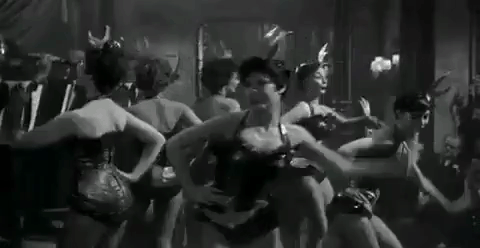
The two talk about what they’re going to do with their upcoming paycheck, with Joe planning on using it for gambling on dog races. Jerry is understandably worried about this, as they owe rent, but Joe rattles off other things that he might was well worry about.
Suppose you got hit by a truck. Suppose the stock market crashes. Suppose Mary Pickford divorces Douglas Fairbanks. Suppose the Dodgers leave Brooklyn! Suppose Lake Michigan overflows.
Fun fact, though: the stock market’s about to crash in a year, Pickford and Fairbanks divorce in 1936, and the Dodgers left Brooklyn in 1957, famously. Lake Michigan has not overflowed...YET. It’s actually at record high water levels, and could cause flooding around it in the next few years. So, although those middle three were DEFINITELY part of the joke...that last one wasn’t at the time. Of course, it’s actually there as a line to set Jerry up with a way to tell him that the streets are “about to flood”, as he spots Mulligan and makes him. He tells Joe, and they both quietly pack up their instruments and leave, BEFORE the ruckus is about to begin.

And begin it does, and the cops raid the place almost immediately afterwards. As the party’s broken up and people are loaded into the paddywagon (Spats included), Joe and Jerry take their chance to escape behind the cops’ backs. However, this also means that the two musicians aren’t getting paid after all. Joe’s still set on betting money on the dog the next day, and get the money for the bet by selling their coats. However, while they do sell their coats, they instead end up looking for jobs at a local music agency, run by Sig Poliakoff (Billy Gray).
The agency is recruited by band owner Sweet Sue (Joan Shawlee) and her nebbish band manager Bienstock (Dave Barry), as they need a bass and a sax player to replace two of their own, in their band in Florida. On hearing this from Poliakoff’s secretary Nellie (Barbara Drew), the two barge into the office. However, much to their dismay, the only ones they’re looking for are women. While Jerry tries to weasel their way in, it doesn’t quite work, and they instead take a job up north for a Valentine’s Day dance. The two go to a garage to borrow a car from Nellie in order to get to the job. There, playing cards, is Toothpick Charlie with a group of men. But then...somebody else arrives.
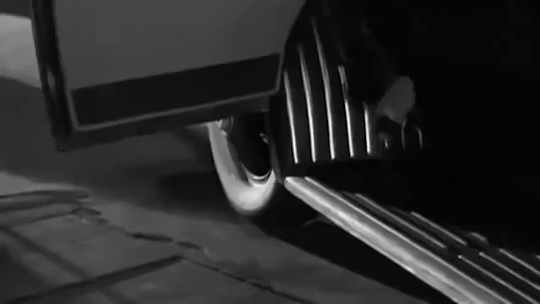
Spats and his men arrive at the garage, and tell all of the men to stand with their hands on the wall. Joe and Jerry, however, manage to hide in the garage. And if you know anything about Valentine’s Day during Prohibition Era Chicago...then you know exactly what’s about to happen to Toothpick and the guys.
After the massacre (based upon the real St. Valentine’s Day Massacre, Jerry makes a noise and alerts the gang to their presence. This is a problem, because Spats isn’t keen on the idea of witnesses, and immediately orders the musicians killed.With a distraction caused by the still-alive-but-dying Charlie, the two manage to escape Spats’ wrath. Now needing a fast way out of town, Joe figures out a plan. See, that job, the one from Sweet Sue, is in Florida, which is far enough away that they should be able to escape. But, uh...the band is only looking for women. And so...
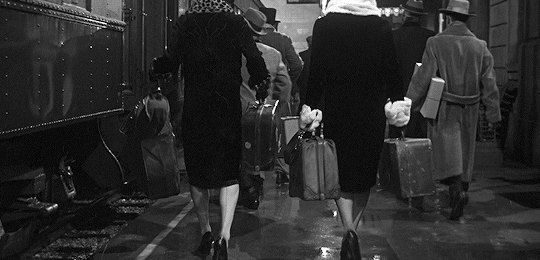
This is the second most famous thing about the film. Meet Josephine and Daphne, the female aliases of Joe and Jerry respectively. As Jerry realizes the difficulties of the female wardrobe (namely skirts and heels), the two walk up to the band of women, known as “Sweet Sue and her Society Syncopators.” But they aren’t the only arrivals, and the other is the MOST famous thing about this movie...

This is Sugar “Kane” Kowalczyk, the lead singer, ukelele player, and...OK, look, it’s Marilyn Monroe, and I think I need to acknowledge this now. Marilyn Monroe is an underrated talent today, but she had a hell of a lot of potential as an actress and as an individual. She had a lot of troubles, and her early death by suicide is an absolute tragedy, no matter how you slice it. She’s a talented actress and singer, and she deserves recognition for that.
SHE IS ALSO INSANELY HOT I’M SORRY I’M WEAK

Look...it’s Marilyn fucking Monroe, OK? I know, I’m a straight cissexual man, but I wanted to make a point to acknowledge the fact that Marilyn Monroe is a talent far outside of her beauty and physicality. She (and all women) deserve that much, and deserve not to be objectified by the male gaze. I genuinely agree with this, and I do understand that concept. I’ll never personally understand the female experience, but it’s my responsibility and duty as an individual to understand experiences foreign to my own, including this one.
But DEAR LORD, her physicality is not easy to ignore, now and then! I mean COME ON! The woman’s considered a standard of classic beauty to this day by many (not by all, and not by herself), and it’s unfortunately her most famous feature to nearly everybody. But, of course, Monroe got a lot of grief for her looks as well (which is bullshit), and the stress of her life sadly led to her terrible suicide. But that doesn’t mean that her beauty inside and out shouldn’t be appreciated for what it is: beauty.
ALSO SHE IS DROP DEAD GORGEOUS I’M WEAK I KNOW
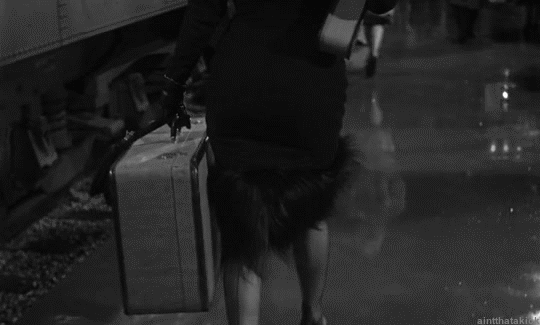
See, the train agrees with me! Oh...OH RIGHT, THE MOVIE! OK, where was I. Well, Joe and Jerry agree with me about Sugar Kane, but it is the 1950′s when the film is made, so of course they do. They watch her get on, and they follow suit, meeting the women of the band, and Sugar Kane. Sugar, see, has a teensy bit of an alcohol problem. That’s not necessarily to say she’s an alcoholic, but she is admonished for it by Sweet Sue and Bienstock, also being a repeat offender of drinking during working hours. That (and men) is something that Sweet Sue doesn’t tolerate.

She’s almost in trouble that night, when her flask falls from her stocking during a performance. However, Jerry covers for her, much to her appreciation. As they settle in for the night, all of the girls (including Joe and Jerry) sleep in the same cabin, much to the, uh, frustration of Jerry, despite Josephine’s urgings to keep it together. As Jerry continually reminds himself that he’s posing as a girl, he’s surprised that night with the appearance of Sugar, who comes to thank her for her help that night. Sugar tells “Daphne” that she owes her one, and also climbs into the cot with him to hide from Sweet Sue. Jerry...that poor mother fucker.

Well, Jerry tries to ease the tension by offering some of Joe’s whisky. But more of the girls overhear this, and eventually, a massive party erupts, with all the girls mixing drinks and sharing the single space of Jerry’s bed. Joe wakes up from all of this, and tries to help end the party, only for Sugar to climb out of it, and ask Joe for help with a block of ice for the drinks.
It’s here that she reveals that she used to work with men’s bands, but joined this band to get away from men. This is especially to get away from her weakness: tenor sax players. This intrigues Joe, the tenor sax player. However, she’s essentially sworn off of tenor sax players because of multiple bad relationships, and is instead hoping to find a millionaire in Florida, preferably one with a yacht. Meanwhile, Jerry’s bed is getting a little too full, and the girls are getting a little TOO familiar. They start to tickle him, and to prevent his cover being blown, Jerry pulls the train’s emergency brake. All of the girls scatter as the train stops, and they manage to get away with the party as Sweet Sue and Bienstock wake up only then.
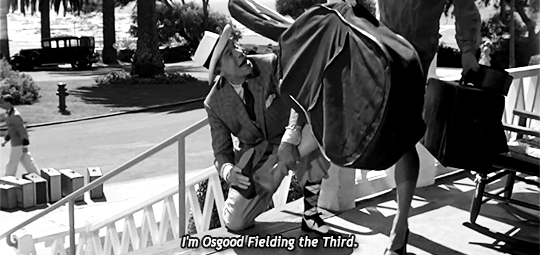
The train gets to Florida, and the girls make their way into a hotel. As they check in, Jerry (as Daphne) is spotted by Osgood Fielding III (Joe E. Brown), a millionaire, and a man with eclectic tastes in women. And those tastes apparently include Daphne, as he unsubtly (and unwantedly) hits on her. And Jerry’s having none of it. After Osgood pinches him in the elevator, he gets off after slapping him. Unfortunately, that makes Osgood only want Daphne THAT MUCH MORE. This man...this man may just be the legendary alpha simp of which the stories tell.
Meanwhile, Joe manages to get ahold of Beinstock’s luggage and glasses. He steals his clothes (after fending off an overeager bellboy), and uses them to dress as a millionaire. Why? Why, to seduce Sugar, of course!
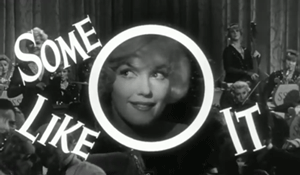
This is right at the halfway point, so we’ll pick this up in Part Two!
See you there!
#some like it hot#billy wilder#marilyn monroe#tony curtis#jack lemmon#george raft#pat o'brien#joe e brown#joe e. brown#comedy april#user365#365days365movies#365 movie challenge#365 movies 365 days#365 Days 365 Movies#365 movies a year#ritahayworth#bbelcher#classicfilmsource#cinemaspam#usersasha#userkaila
11 notes
·
View notes
Text
Esquire Singapore Dec 2019 - Joel Kinnaman Interview
OBSERVERVABLE ACTS

Editor-in-Chief: Norman Tan
Photography: Michael Schwartz
Stylist: Chloe Hartstein
Groomer: Kristan Serafino
Story: Wayne Cheong
Instead of a rooftop shoot that we had planned, we’re indoors at Dune Studios on Water Street. Outside, the weather is every writer’s dream: “It is an ash-streaked sky that portents a downpour.” “Like a warning, steel wool hangs overhead.” “A dishevelled blanket of grey that drifts languidly like detritus in a muddied pond.” A wet weather doth not a good shoot make.
When Joel Kinnaman arrives, the first thing you notice is how large he is. Bigger than life, broad-chested, he sometimes stands astride, like he’s about to break the spirit of a wild stallion. Then, there’s that presence; a sort of aura that’s quiet but still strong-arms you for your attention.
Just as the fashion shoot is about to start, Kinnaman asks if he could put on his own playlist for the shoot. He brings up his Spotify playlist, titled ‘For some of mankind’. ‘What Becomes of the Brokenhearted’ by Jimmy Ruffin plays.
“The playlists are just for fun,” Kinnaman tells me. “I’ve made a playlist for every project that I’ve been in.”
The project that this particular playlist was made for is For All Mankind, now playing on Apple TV+. It’s a show that puts forth the idea: what if America lost the space race to Russia?
Created and written by Ronald D Moore, the visionary behind the reimagined Battlestar Galactica and Outlander, For All Mankind stars Kinnaman as Edward Baldwin, a NASA astronaut who works alongside Buzz Aldrin (Chris Agos) and Neil Armstrong (Jeff Branson). Kinnaman’s character isn’t based on a particular historical figure, instead he is a composite or a representative of the ‘all-American’ astronauts of that era.
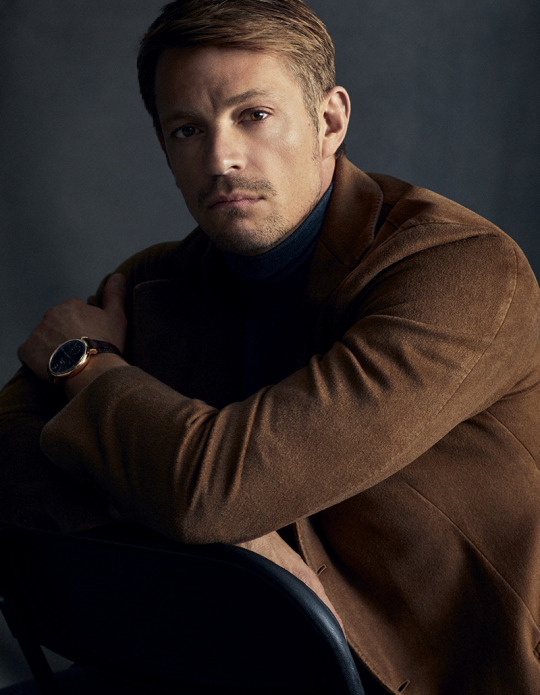
“I’m half-American and half-Swedish,” Kinnaman says. “I’ve lived in Sweden and America so, in a way, I’ve a split identity. My favourite part of the American spirit is not giving up. If they get knocked down, it is a national honour in getting back up and continuing the fight. In reality, when the US got to the moon, it concluded the space race. We didn’t get the continuation in space exploration that everyone was promised.”
Kinnaman is drawn to the science-fiction genre, fantasising of what could have been (though it can be said that the broad field of fiction can also put forward, ‘ what if’). Growing up, he watched the Star Wars movies, he loved the cyberpunk feel when he shot Altered Carbon. He is a fan of Blade Runner due to its dystopian future.
Do you think that sci-fi’s dystopian trope is becoming a reality? Kinnaman muses on that. “We’ve a president who is a national and international embarrassment. He’s immoral, a compulsive liar, a narcissist who doesn’t respect or appreciate democracy. I pray and hope that this nightmare would soon come to an end.
“But I believe we have the potential to overcome this. If we change paths and realign our focus in coming together as a human family, we can solve whatever problems that come our way together.”
This sentiment is echoed in For All Mankind, although the loss wasn’t the be-all and end-all for America. According to Moore, in losing the space race, America ends up the winner in the long run because of the continual effort into space exploration.
“Art can be a little lazy in pointing out the negatives. In many instances, the role that art and the artist play is showing us what’s wrong: that’s important but showcasing the positives is equally important. For All Mankind shows us how we should be operating if we are guided by our better angels.”
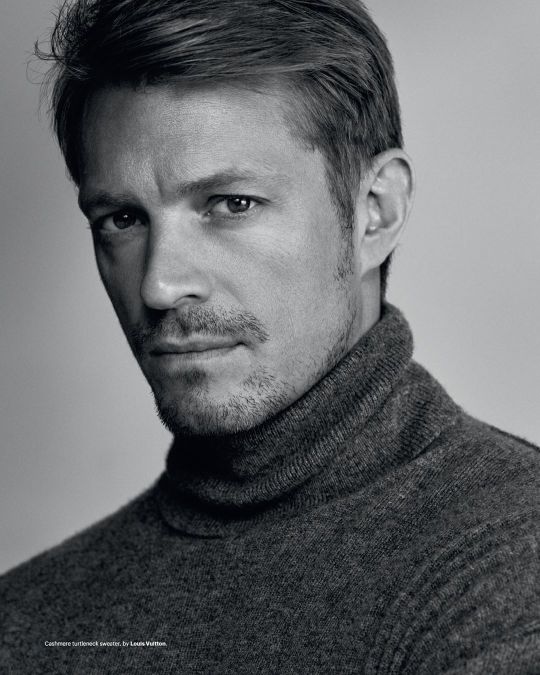
Physicist and theoretical biologist, Erwin Schrödinger, came up with a thought experiment. Imagine, if you will, a cat that’s sealed in a box. And inside that box is a device that might or might not kill the cat. Quantum theory states that quantum particles can exist in a superposition of states at the same time. Some even theorise that the quantum particles will collapse to a single state when it’s observed. When applied to Schrödinger’s cat, the feline is both dead and alive until you open the box.
Schrödinger came up with this thought experiment to explain that “misinterpreted simplification of quantum theory can lead to absurd results which don’t match real world quantum physics”. In the real world, it’s absurd that the cat is both dead and alive at the same time.
But one can also see this as an example of how the scientific theory works. Nobody really knows if a theory is right or wrong until it can be tested and proved. It’s like asking someone out on a date, you don’t know if that cute girl or guy will go out with you until you ask; the possibilities of rejection and acceptance remain in co-existence.
That is before you open the box.
Observe: Joel Kinnaman wouldn’t have existed if his father, Steve, had not defected from the US Army. An Indianapolis native, the elder Kinnaman was drafted and stationed in Bangkok, Thailand during the Vietnam War. While he was there, he started spending time with European backpackers, who have a different perspective of the war. A seed was planted. It finally blossomed when he attended a friend’s wedding in Laos. “It turned out that the woman’s family was half Laotian and half Vietnamese,” Kinnaman says. “It was an emotional moment for my dad. He asked himself if these were the people that he was going to kill.”
Still reeling from the love he had witnessed, the elder Kinnaman returned to his base. It was then that he was given the news that he was being reassigned to the battlefront in Vietnam.
In the history of war, the common punishment for desertion is death. According to the US Uniform Code of Military Justice, Article 85, it is meted out “by death of other such punishment as a court-martial may direct”. (Since the Civil War, only one American serviceman was executed for desertion: Private Eddie Slovik in 1945.)
Knowing the penalties for desertion, the elder Kinnaman made the decision that night to leave camp. He hitchhiked his way up into northern Thailand and into Laos. He burned his passport, changed his name and passed off as Canadian. For the next four years, he lived life among the Laotians doing odd jobs. Then, he found out that Sweden grants asylum to Vietnam deserters. Since moving to Sweden, President Jimmy Carter eventually issued an amnesty in 1977. The elder Kinnaman continues to reside in Sweden. After his first marriage ended, he was involved with Bitte, a therapist. This relationship yielded Joel.
“I’ve been working on the script about his life,” Kinnaman says. “The idea would be that I’d play my dad but I’m getting a little old.” It’s a story to be told, one about the dangers of blind patriotism; a tool that’s often exploited by governments. “We need to be critical individuals who should make up our own minds.”

Observe: Kinnaman had his first taste of acting when he was 10. He played Felix Lundström on Storstad, a soap opera that looks at the lives of the residents living in the fictional town of Malmtorget. Back then, Sweden had only two TV channels so even if it’s a secondary or even tertiary role on an ensemble piece, people will recognise you. “I didn’t understand it,” Kinnaman says. “There was something thrilling about being famous but there was something I didn’t like about it either.” His whole experience as a child actor was underwhelming.
In fact, taking a page from ��history repeating itself ’, observe as Kinnaman could have been a soldier in the Swedish army.
“It was mandatory for the men to be conscripted for a year in the army and it was during my time when the rules for enlistment started to relax,” Kinnaman says. “If you didn’t want to enlist, all you have to do is purposely fail the proficiency tests.”
Alas, Kinnaman was so caught up in the competition that he aced it. His results showed potential to be a company leader. He was enlisted and assigned to an 18-month tour in the Arctic Circle but Kinnaman plum forgot about it. When he moved to Oslo, Norway, to be a bartender, he received a call from his mother, informing him that there was a government notice stating that he was supposed to enlist in three days.
He called the army to tell them that he was no longer in the country. “They said, this is a serious offence and I could get prison time for this. But if I were to write a letter to explain the situation, I could get out of this.” And then he forgot to write the letter. Kinnaman continued working odd jobs but he was always haunted by the thought that if he were ever to be arrested by the police for anything, they might discover his draft dodge from his records and he would be sent to prison.
“I ended up at this fight outside a night club and got taken in by the police.” Kinnaman says. Observe: Kinnaman could have ended up serving his sentence for draft dodging but nothing came of it.

Acting was calling out to him once more. His friend, Gustaf Skarsgård (famously known for his role as Floki in History Channel’s Vikings), was on track to becoming an actor and advised Kinnaman to apply for theatre school. After several applications, Kinnaman finally got into what he describes as “Sweden’s second-best acting school” and would go on to film two movies during his enrolment.
After graduation, he continued acting in Sweden before moving to America. He kept himself busy. He made an appearance in The Girl with the Dragon Tattoo; starred as Governor Will Conway in House of Cards; made people notice with his portrayal as the homicide detective, Stephen Holder; scored the lead role in the Robocop remake; was cast as Rick Flag in Suicide Squad.
The one genre that Kinnaman can’t seem to appear in is comedy. Yes, he has a stern demeanour but the man is also funny. “Sometimes, Hollywood sees you in a certain way and it’s much easier to get cast for it. And the next is similar to that and so on. I haven’t made an effort to dissuade people’s opinion. The lighter side is probably more me.”
The closest he has gotten to doing comedy is the shooting of the Suicide Squad sequel. Helmed by James Gunn, Kinnaman said in another interview that it feels like he’s “shooting his first comedy”.
“I’ve been around tough people with issues before,” Kinnaman continues. “I’ve had some bad times so those kind of environments were natural to be in. It’s a survival mechanism too. A way for me to cope as I grew up. At the time, you’re figuring out about your identity. I felt insecure, powerless and didn’t know what to do in life.
“It was a period of my life that was pretty negative. But one of the beauties of acting is that those dark periods become a mother lode that you can mine from. Maybe I’ve drawn a little bit too much from it by playing too many tough guys.”
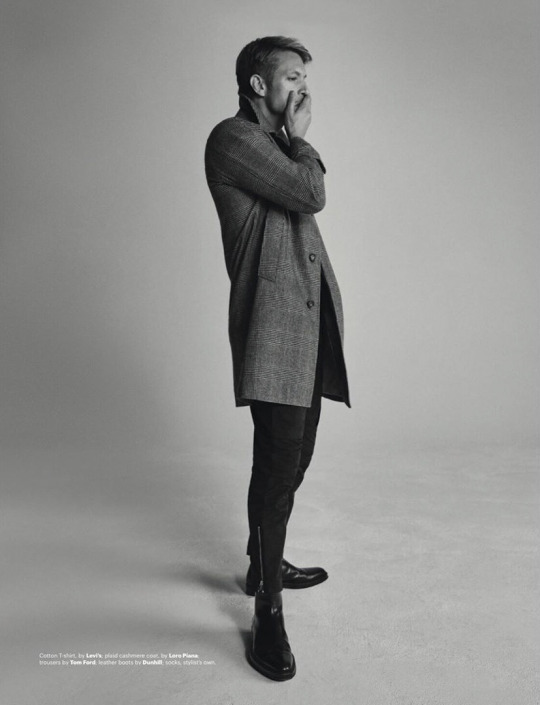
In May 2016, Kinnaman was one of the delegates and personalities from Denmark, Norway, Iceland, Finland and Sweden who was invited to one of President Obama’s final state dinners. Kinnaman, dressed in a sharp tuxedo, attended the dinner with his then-wife, Cleo Wattenström.
He overheard that the Obamas were fans of House of Cards and was looking forward to being introduced to them. At the reception, he and the other representatives stood in a row as President Obama made his way down the line, shaking hands and posing for a photo op. By Kinnaman’s admission, his mind wandered as he imagined what he’d say when President Obama came up to him. “Maybe I’d say, ‘Mr President’, and then he’ll say ‘Governor Conway’, and then we’ll laugh. And we’ll end it with a cool handshake.”
And all of a sudden, the president stood before him and Kinnaman muttered, “Mr President…” There was an awkward pause. Kinnaman would recount that it’s very possible that either the Obamas hadn’t watched the episode that he was in or if they did, his presence made zero impact. Before the silence could prolong, Kinnaman ended with, “thanks… for everything”. President Obama said something along the lines of, “Surely but surely, we cannot lose hope” and Kinnaman was ushered off.
He would retell this story when he introduced President Obama at Brilliant Minds, a conference of creative individuals who embody the forward-thinking spirit of Sweden, in June 2019. After the introduction, he returned backstage, where President Obama was waiting for his cue to go up. “He had this huge smile on his face and he said to me, ‘bring it in for a cool handshake.’ We hugged, we talked for about five minutes. He was super friendly. I’ll always remember that moment.”
Kinnaman isn’t shy about his politics. He voiced support for the #metoo movement; he had championed the environmental cause by one of his fellow Swedes, Greta Thunberg; he does not hide his disdain for the Trump administration.
“I think the last UN report stated that we have about eight years to turn back our carbon expenditure into the atmosphere,” Kinnaman says about where we’re heading as a species. “You don’t have to be a prophet to see that the world is heading towards the wrong direction. The oceans are heating up, the glaciers are melting. These natural disasters will be more frequent and that’s gonna lead to more tensions among countries.
“Politically, we’re moving towards a more nativist direction; people are pulling away from international cooperation. There’s the rise in disinformation campaigns, which will threaten democracy.”
But Kinnaman, ever the optimist, still believes in the human spirit, that we can innovate our way out of this quagmire.

Observe: Kinnaman, who was born with pectus excavatum, chose to correct the disorder instead of living with it.
Pectus excavatum is a chest-wall deformity that affects roughly one in 400. Instead of the breastbone being flush against the chest, it sinks in. Measured on a scale called the Haller index, anything above an index of 3.2 is considered severe. Kinnaman’s index was a seven or an eight.
“It’s something that’s survivable,” Kinnaman explains. “But it’s a condition that grows worse over time: your posture becomes worse; your stamina worsens as your heart is not given room to pump. By correcting it you can add years to your life.”
For a condition this severe, doctors had to insert two curved metal bars across his chest. Then the bars are turned to force the chest out and then the bars are wired to his ribs. The operation changed his life for the better. He doesn’t feel self-conscious whenever he removes his top. Six weeks after his surgery, he had to do reshoots for Suicide Squad. It was a fight sequence but Kinnaman sucked it up. “Would you like to feel it?” He asked.
He raised his arm like an invitation. I reached out and felt the spot, where the metal bars are, beneath the fabric and skin.
That’s an interesting party trick, I say. Kinnaman could only chuckle in response.
“It’s funny, if you ask me to say a line from a movie that I’ve been in before, I can’t. Not one line from any movie that I’ve done but I once did a monologue that was one hour and 30 minutes and I knew it by heart after 10 days.”

Kinnaman used to opine that as a Swedish American, growing up with dual cultures gives him a better perspective of the world but that also left him feeling like he doesn’t belong. He jumps from place to place, leading a nomadic existence.
“But I think,” he says as though he had stumbled upon some great truth a long time back, “I don’t wanna travel so much any more. Home. That’s where I’d like to be. I have two bases: one in Venice, LA and the other, an hour outside Stockholm.
“Growing up, my family didn’t have any money. We lived in this tiny little cottage that was in the middle of the woods. Now, I have this piece of land, where my family lives. This past midsummer was the first midsummer that we all spent together.
“That’s my new happy place.”
Joel Kinnaman looks like a man who has placed the final piece in that mystery of his life. He has stopped worrying about how he’s perceived by the public. He has exorcised people who have “struggled with jealousy, who don’t have a natural inclination towards generosity”. He has zero tolerance against bullshit. He likes how his career is shaping up—aside from Suicide Squad 2, For All Mankind is now filming a second season, and Kinnaman has three films coming out: The Informer; The Sound of Philadelphia and The Secrets We Keep; the last two, he avers, are his best work. “People who have watched me for a long time, it will remind them of my early career and for people who recently followed me, they will see a new side of me.
“I have goals that I’d like to achieve. Actor awards are such bullshit… until you get one. But yeah, that would be great. In future, I’d definitely want to be in a producing role and at some point, I’d like to also direct.
“I’ve said that I’d direct in five years time for about 10 years now.” That might change. His life is still a long and open road ahead.
Schrodinger’s cat posits two states that the creature can be in—dead or alive. But what if there’s a third option. That within the confines of the box, the cat is not there. It’s escaped. Unburdened from the stipulations of a thought experiment, free to do what it wants.

#photoshoot#magazine#joel kinnaman#esquire singapore#interview#we feed on scraps of new info#ive linked his Spotify playlist for people who missed it in march
184 notes
·
View notes
Photo

ALTERNATIVE STYLE ICON: RICHARD CHAMBERLAIN IN WALLENBERG: A HERO’S STORY
by Réginald-Jérôme de Mans
The writer George Santayana famously wrote that those who cannot remember the past are condemned to repeat it. Ironically many who repeat his quote forget who first uttered it.
I had long meant to write about Richard Chamberlain in this role. I once referred to him as “the fey king of the miniseries” and I don’t regret it: foppish, almost milquetoast in fare as varied as a two-part TV version of The Bourne Identity (with Jaclyn Smith, natch), Shogun, and as a leading candidate for an honorary Seinfeld puffy shirt: Not only did he play the Count of Monte Cristo in a 1975 TV movie, but a bunch of what Elaine Benes would have called chandelier-swinging characters in other Dumas adaptations, including Aramis in Richard Lester’s The Three Musketeers and Louis XIV and his twin in The Man in the Iron Mask. Postmodern swashbuckler author Arturo Perez-Reverte even described a character in one of his own novels as looking “like Richard Chamberlain in The Thorn Birds, only more manly.” That same Thorn Birds role, Father Ralph de Bricassart, also inspired a certain Rhunette Ferguson to give her son, a future New York Jets player, perhaps my favorite name ever: D’Brickashaw.
Dubbing Chamberlain an Alternative Style Icon for his role as Swedish diplomat Raoul Wallenberg is low-hanging fruit. For years this TV special dwelt at the bottom of my Netflix queue for that express purpose. Former Savile Row tailors Manning & Manning won an Emmy award for the outfits they made for him; decades later Bryan Manning had some very interesting things to say to the inimitable Simon Crompton of Permanent Style about the 1930s and 1940s cutting styles he had to adopt for Chamberlain’s outfits for the movie. Chamberlain’s costumes are appropriately dashing, from the full diplomatic gala white tie ensemble worn while conspiring with the Papal Nuncio of Budapest to a tan double-breasted suit with horizontal peaked lapels that is, quite simply, magnificent.
Zagreb, one of the most beautiful cities in eastern Europe, admirably filled in for 1940s Budapest and Stockholm in the making of this production. I’m fairly certain that I’ve stayed at the Zagreb hotel on whose esplanade Chamberlain wore that suit, in an early expository scene where the American and Swedish governments encourage Wallenberg to take a position with the Swedish legation in Budapest. I’ve been told Zagreb’s one of two cities in Europe where the street lamps in certain neighborhoods are still gaslit. Gaslighting happens to have been one of the reasons that I finally wrote about this icon.
Of course there’s plenty to mock in the conventions of this telefilm, even beyond Chamberlain’s indisputable 1970s and 1980s stock hero status: its heavy-handed setup and plotting, making Wallenberg out to be a one-man anti-Nazi force from his time at home in Sweden (wearing a U. Michigan sweatshirt to indicate that he had studied in the US - did college sweatshirts even exist back then?). Miniseries meant melodrama and its archetypal characters: an adorable child whom Wallenberg saves from the death camps only to die of illness; a shoehorned-in love interest in the form of a kindhearted baroness who lobbies her suspicious husband to relax the Hungarian government's strictures on Jews; a fiery Hungarian resistance fighter who provides the unofficial, combative counterpoint to Wallenberg’s diplomatic, humanitarian efforts through official channels. And, of course, Wallenberg’s kidnapping by the Soviets at the fall of Budapest meant his story was perfectly framed for 1985, when we still couldn’t trust those Russians. (In fact, to this day no one knows what they did with him.)
A few appropriately haunting and powerful moments do ring true, including Wallenberg’s cordial verbal fencing matches over contraband Scotch and cigarettes with Adolf Eichmann. Whether those meetings really took place in that form or not, their film versions appropriately capture the realities of how we are forced to engage with evil. Rarely are we simply battling an easily identifiable other, weapon to weapon. Instead, we encounter evil in the everyday – in fact, it seeks us out, finds shared ground, converses with us over pleasantries and hospitality even as we recognize its intentions. It identifies with us, we identify with it. Even as you know it is evil.
Eichmann had made it his avowed duty to kill the Jews of Europe. Wallenberg’s mission, as an emissary of an officially neutral power, was to help save as many as he could. And he did, through famously fearless, reckless endeavors including the distribution of thousands of official-looking Swedish passes to the Jews of Budapest, the creation of vast cultural centers and warehouses in the Swedish mission buildings in which these new countrymen could work under the aegis of their adoptive country, and savvy diplomatic maneuvering with the Hungarian and German authorities and military. He went as far as to climb on top of a train bound for Auschwitz and distribute passes to as many deportees as he could while soldiers fired shots at him. Looking back, historians suggest they were firing over his head to warn him as they could easily have dropped him at that range, but it’s not likely Wallenberg knew that at the time.
At that time diplomats of neutral powers could make fortunes more safely as armchair heroes: playboy Porfirio Rubirosa reportedly did so in Paris selling visas to the Dominican Republic to French Jews during World War II. In that respect, perhaps, both he and Wallenberg were heroes… of different sorts.
Wallenberg did not do it for money. The Wallenbergs were Swedish aristocracy (with, the film takes pains to remind us, an ounce of Jewish blood) with considerable means – hence the finely tailored wardrobe for Chamberlain. Thus, an easy cynical response to this essay could be that a rich aristocrat with diplomatic immunity risked nothing swanning around the salons of Budapest, just like the fictional gentleman spies we read about and watch on screen.
That response is wrong. Heroism is not just born of opportunity. It is recognizing when a choice confronts you and taking the difficult, unpopular and dangerous one in order to do what is right. Fictional heroes like Bond or Steed rarely suffer meaningful personal loss and rarely confront the reality of evil. Evil is your friend with many positive qualities, maybe more intelligent or cultured or better dressed than you, the one you looked up to, who gradually reveals the awful things he or she believes and has done. Evil is those complicit in carrying out those things by their inaction, their credulity, or their cooperation, not at the point of a gun but of a paycheck. Evil is legal, logically explained, repeated and reported until its baseless reasoning becomes fact and the foundation for more lies, more evil. Evil can so easily become the system.
Hindsight is a handicap, for it doesn’t usually permit us to see that there were no times without ambiguity in battles between good and evil and no certainty that good triumphs. We have the privilege of retrospect to acknowledge the dashing diplomat in Savile Row suits was a hero for saving innocents from deportation and death as part of the most ghastly genocide in history. We learned what genocide is, and had to invent the word to describe it. Because at that time the people singled out for persecution and death were unpopular, historically, socially and legally marginalized, supposedly easily identifiable and classifiable. A group that societies had made it easy - through regulation, ghettoization, oppression and antagonism – to hate, and whole false narratives drawn up to explain why that group hated and wanted to destroy us even more than we them.
One of A Hero’s Story’s most timely and inspiring lines is Wallenberg’s reply to the Hungarian ruler’s query why the King of Sweden cared so much about the Jews of another country, when he was a Christian. Wallenberg reminded the prime minister that the King’s “concerns transcend religion or national borders.” That concern is humanity, our lowest common denominator, our shared recognition of our capacity for suffering. That concern drove a man to acts of incredible selflessness, a generous mercy that seems to have cost him his liberty and his life. There is no romance to Raoul Wallenberg’s fate. It is worth remembering that he probably saw little romance in the actions he took in Budapest.
Now is no less an unromantic time, no less a time when others – so many different others –are easily denigrated, feared, distrusted, brutalized. Otherization, both of many within our borders and pressing against them, has returned, as has fascism, with apologists blandly elegant or brutally populist, like some inauspicious comet in our skies. Now, again, is a time for heroes – men and women who recognize how difficult and dangerous it is to do what is right. That struggle is far from those of Chamberlain’s habitual roles swashbuckling against a monolithic, universally despicable, evil. Evil is among us, habituating us, desensitizing us, gaslighting us. Far from frills and fanfare, celebration, or certainty of triumph, can we place ourselves in Wallenberg’s Budapester shoes and do what is right?
Quality content, like quality clothing, ages well. This post first appeared on the No Man blog in February 2017.
8 notes
·
View notes
Text
IT HAPPENED LAST NIGHT: LUCY & THE BOMPS!
by Earl Wilson, August 19, 1950


Lucille Ball wanted to keep Desi home and off the road so she petitioned for him to play her husband on radio’s “My Favorite Husband”. The network balked and Richard Denning got the role instead. When it came time to transfer the show to television, Lucy made the same demand. Now a radio star in her own right, she was able to convince the network - nervous about America believing an ‘All-American girl’ like Lucy would be married to a Latin bandleader - to give them a chance to prove it! The Arnazs’ built a comedy and musical act and took it on the road. When the show got to the Roxy in New York City, syndicated columnist Earl Wilson tagged along and wrote the following feature, which appeared on August 19, 1950. Coincidentally, the Roxy was also the theatre where Desi Arnaz was performing when he wed Lucille Ball in 1940.
[NOTE: Although the text of Wilson’s article is repeated below verbatim, the photos and footnotes were added for editorial consideration.]

Lucille Ball has been one of our most appreciated movie actresses for quite a while, but it was seeing her do a bump on the stage that made me really come to realize how talented she is.
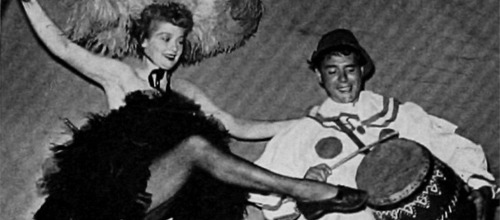
It was after she’d done her clever act with husband Desi Arnaz at the Roxy that I talked to the flamin’ redhead about it.

“Wasn't that a bump?” I asked her, as we got into a cab and pulled away from the stagedoor. I wanted to be sure, because some snooty actresses wouldn’t want it thought that they ever did a bump.“That was a married woman’s refined version of a bump.”
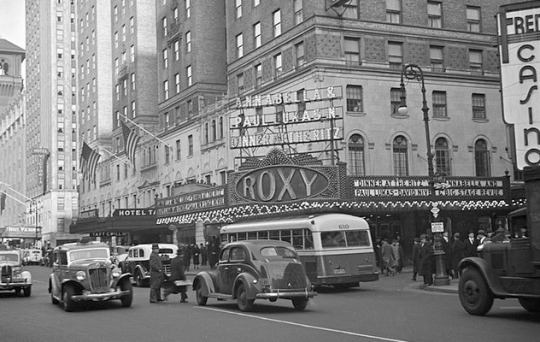
Lucille was sitting back in the cab, exhausted from several shows that day, and clamoring to be taken somewhere to see a show. She said she had been entertaining all day and now she wanted to be entertained for a change.

“Did you say refined?” Desi looked across the cab at her. I was between them. “Any harder you do it and you will knock my hot off,” he said in his charming accent. (1)

At Desi’s urging, she told me a story showing that doing the bump is for her not new. It seems that once she made a picture for Eric Palmer called Dance, Girl, Dance. (2)
“He was telling me, ‘Those bomps. Don’t do those bomps bad or the sansors will keep the picture.’
“So I was doing a very tame dance, not bumping at all. I had on a 27-pound dress, silver lame, with bugle beads, and it rolled from side to side when I shook.
“Durin’ a scene, Palmer jumped up and said, ‘Oh, oh, that was a bomp. I told you no bomps.’
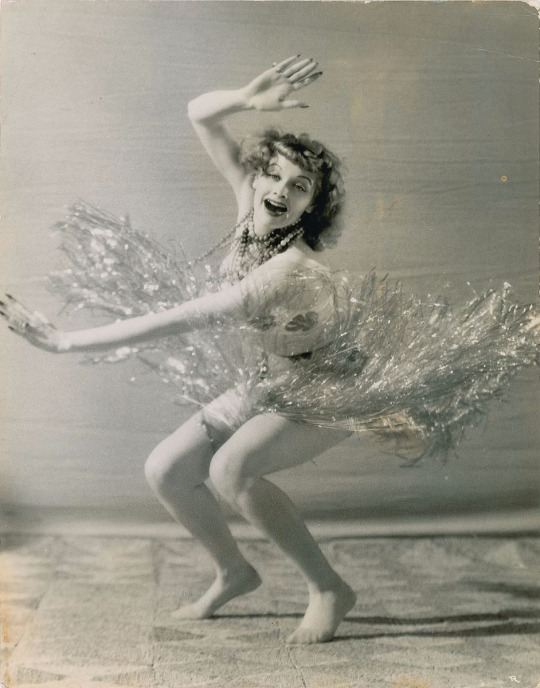
“I went up to him and I said, ‘Mr. Palmer, that was not a bomp. THIS is a bomp.’ “And I bumped and I wrapped those 27 pounds of beads right around his neck!”
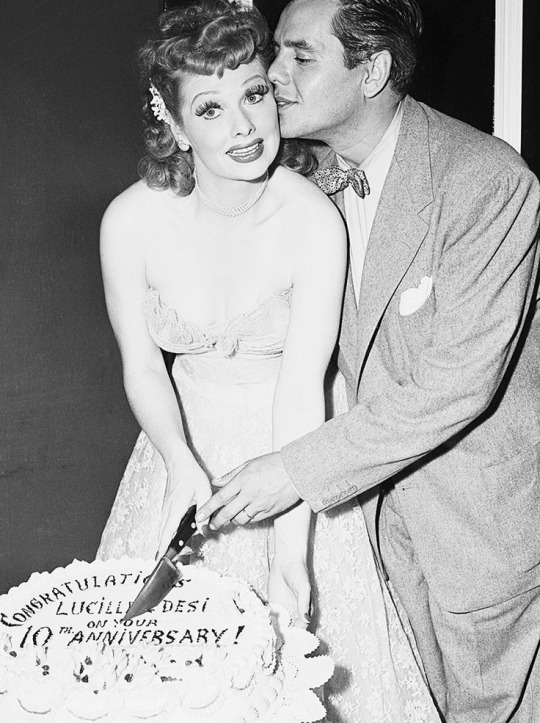
It’s a pleasure to talk to two such honest, earthy people after listening to some others who are always posing. A lot of people are astonished that they are celebrating their 10th wedding anniversary because, as Desi points out, “Everyone said it wouldn’t last a month.” “And WE didn’t think it would last a week,” Lucille said. (3)
Being romantically inclined, I asked for the details which most everybody must have forgotten by now but the participants themselves.
“Where did you get married?” I asked Desi.

“The Byram River Beagle Club, at Greenwich, Conn.,” Lucille said. (4)
“Thank you, I can never say that,” said her Cuban husband.
“Yes, you can. Try it,” Lucille said.

“The By-ram River Bee-gul Club,” Desi said dutifully and slowly.
“Faster!” commanded Lucille. (5)
“The Byver Regal Civer Club,” responded Desi.

“Oh, my,” said Lucille, “We were married by Judge John J. O’Brien. He’s the one who married Tommy Manville so many times.” (6)

Although Desi missed a show at the Roxy, where he was then appearing, to get married, he remembers, just as vividly, how on his wedding night he woke up the bride about 5 A.M. and demanded that she get him a glass of water. The funny thing is that she did.
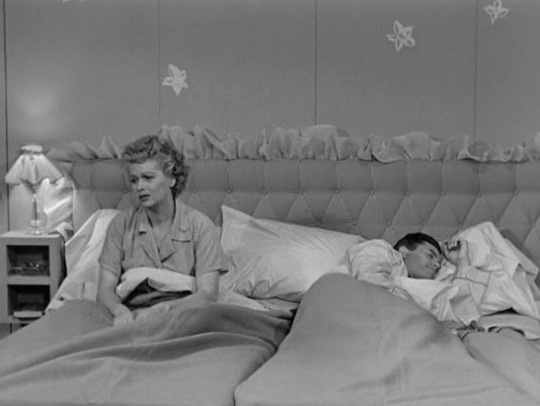
“About 9 o’clock she woke me up,” Desi recalls, “and she said ‘Listen, you—, the next time you want a glass of water you get it yourself!’” (7)
Desi explains that he’s never made such a request since.

Desi and Lucille have formed their own company which they call Desilu Productions, this being a combination, of course of their two first names. “First time I ever got top billing,” Desi says.

They plan to do concerts, radio, television and movies together. Lucille comes from Butte, Mont., and, as everybody knows, has red hair. (8)
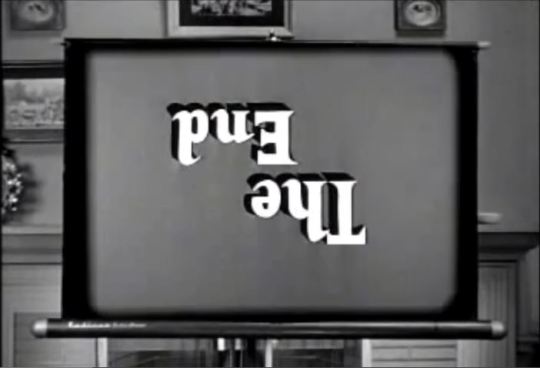
Lucille made up a description of herself around which a movie will be made. The title which describes her so accurately is "Blazing Beulah From Butte," and we figure it ought to get the money. (9)
Never underestimate that Desi.
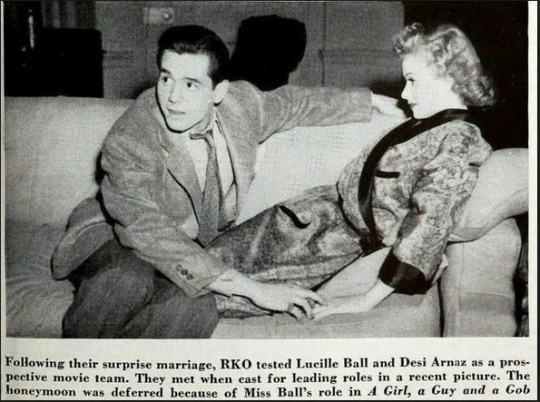
When they were getting married it appeared that she might not be able to because of a commitment to Harold Lloyd.
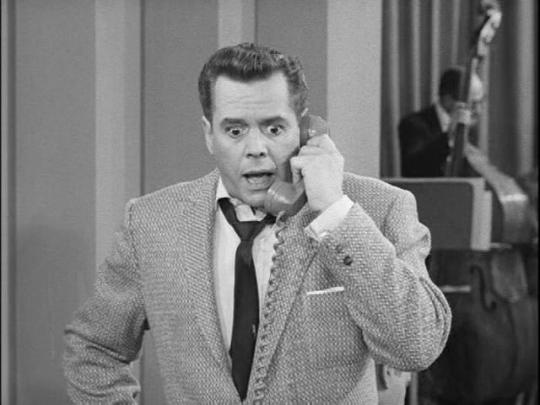
Desi called Lloyd from New York and defiantly announced to him that Lucille couldn’t be available that week, as he was marrying her. “Y-yes, D-desi, c-can she be back next k-weeek?” stammered Lloyd, who never does. (10)
Desi is pretty masterful; when he speaks, to Lucille he is her master’s voice.
FOOTNOTES
(1) The ‘bomps’ discussed are undoubtedly from the “Cuban Pete / Sally Sweet” number, where Lucy gyrates her hips while singing “Chick-Chicky-Boom Chick-Chicky-Boom.” The routine was repeated (with ‘bomps’ included) on “I Love Lucy” in “The Diet” (ILL S1;E3) in October 1951.
(2) The article consistently mis-spells Erich Pommer as ‘Eric Palmer.’ Pommer was the producer of Lucille Ball’s 1940 film Dance, Girl, Dance at RKO.
(3) Lucy and Desi’s marriage lasted twenty years, from 1940 to 1960, although Lucille divorced Desi in the mid-1940s, Lucy never signed the paperwork. After their second divorce was final, Lucy revealed that Desi was unfaithful and a drinker, and that they were no longer compatible. Lucy charged “mental cruelty” and told the court of Desi’s temper tantrums. Some years later, she described the reason for the split as “the same old booze and broads.” Both Ball and Arnaz remarried, although they stayed friends and later admitted that they had always loved one another.
(4) Lucy and Desi married in Connecticut due to its shorter waiting period on licenses and blood tests. The Byram River Beagle Club in Greenwich was originally a Hunt and Kennel Club that became a speakeasy during Prohibition and after that a supper club. It was a favorite hangout of baseball great Babe Ruth. A single-family home now stands on the property. In April 1952, “I Love Lucy” aired an episode called “The Marriage License” (ILL S1;E26) that was largely set in Greenwich and mentioned The Byram River Beagle Club, although no scenes were set there because Lucy purposely left Ricky’s wallet at home and they ran out of gas!
(5) In “The Marriage License” Ricky also had trouble pronouncing the name. On “I Love Lucy” making fun of Ricky’s English was a usual source of comedy - mostly by Lucy - just as it appears to be here - in 1950.
(6) Thomas Franklyn Manville, Jr., known as Tommy Manville (1894-1967), was a Manhattan socialite and heir to the Johns-Manville asbestos fortune. He was a celebrity in the mid-20th Century due to both his inherited wealth and his record-breaking 13 marriages to 11 women, which won him an entry in the Guinness Book of World Records. At the time of this interview, however, Manville was only on his 6th wife! The termination of his marriages usually resulted in gossip, widespread publicity, and huge cash settlements. At the time of his death it was estimated that Manville spent more than $1.25 million on divorce settlements.
(7) This exchange (with slight variation) was later worked into “I Love Lucy”!
(8) At the start of her career - and apparently well into 1950 - Lucille Ball purported to have been born in Butte, Montana, despite her actual birthplace being Jamestown, in upstate New York. Ball (who then went by the name Diane Belmont) thought it sounded more interesting and exotic.
(9) Despite the alliterative title, "Blazing Beulah from Butte” was never made, perhaps because shortly afterwards Ball admitted her true birthplace. “Blazing Beulah from Jamestown” doesn’t have quite the same ring. It’s also likely that this was a clever bon mot on Desi’s part to create a more colorful interview.
(10) Comic actor and director Harold Lloyd had put Lucille under contract for his film A Girl, A Guy, and A Gob, to be filmed in 1940. There was some speculation that marrying Arnaz would interfere with the shooting schedule.
TRIVIA

While Lucy and Desi were at the Roxy, the theatre was also showing Night and the City, which had premiered there on June 5, 1950. At this time it was common for a larger entertainment venues like the Roxy to present both a stage show and a first run film. Night and the City starred Richard Widmark, who Lucy and Desi later convinced to guest-star on “I Love Lucy” in “The Tour” (ILL S4;E30) in May 1955.

In “Return Home From Europe” (ILL S5;E26), Ricky gets a long-distance telephone call from the manager of the Roxy, Mr. Rothafel, offering him a job, if he can get back to New York immediately. In reality, Rothafel was the name of the founder of the Roxy, Mr. Samuel ‘Roxy’ Rothafel. Rothafel died in early 1936, however, so this was probably Desi’s way of honoring him.

Earl Wilson was mentioned on “I Love Lucy” in “The Fox Hunt” (ILL S5;E16). While trying to wangle an invitation to Sir Clive’s country manor, Lucy makes up a story about the Mertzes meeting an Earl in the hotel lobby. When Sir Clive rattles off the names of some Earls to jog her memory, she fibs that he was just promoted from Assistant Earl, the Earl of Wilson, who canceled because he’s got the gout! Lucy’s imaginary Earl is actually a reference to Earl Wilson (1907-87), a journalist and television panelist of the time. His nationally syndicated column frequently mentioned Lucy and Desi.
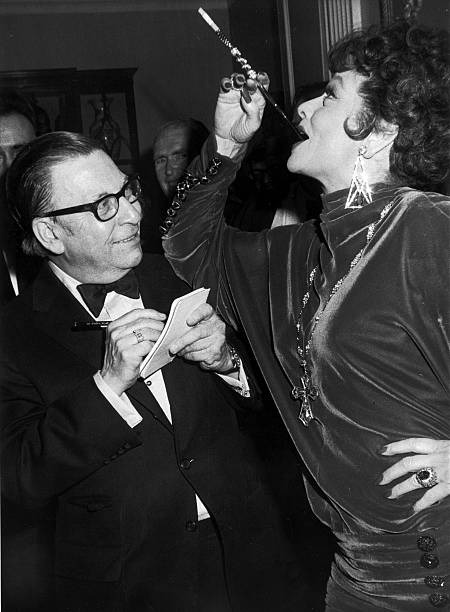
In 1974, Lucy strikes a pose for Wilson during her promotional tour for Mame.
#Earl Wilson#Lucille Ball#Lucy#Desi Arnaz#Desilu#Roxy#Byram River Beagle Club#1950#I Love Lucy#Mame#Night and the City#Tommy Manville#A Girl A Guy and a Gob#RIchard Widmark#Dance Girl Dance#Erich Pommer#Vivian Vance
4 notes
·
View notes
Text
Pondering GODZILLA: KING OF THE MONSTERS (2019)

Director Michael Dougherty amply demonstrates his credentials as a Godzilla fan in bringing to the screen a film that lovingly references myriad aspects of the various Toho series since 1954. This lavish and detailed homage to the legacy of Godzilla is full of nods that aficionados will find delicious and our favorite daikaiju have never looked more conscious and gloriously alive. It is crafted in an American summer blockbuster style in its breathless pacing so that one has to be quite sharp to spot all the goodies he’s woven into this third episode of Legendary’s MONSTERVERSE. While Gareth Edwards’ 2014 GODZILLA employed a Spielbergian touch, Dougherty offers the most Toho-esque installment so far in this franchise.
Essence of Toho
In my review of the 2014 Edwards film, I had speculated that a MONARCH-centered approach would be best going forward, and indeed that has been the case with both KONG: SKULL ISLAND and this film. Dougherty has taken that Toho Showa series’ leap into “super science,” with defensive masers, secret bases around the globe enveloping recumbent daikaiju, and the ORCA device, meant to communicate with the Titans. This approach, sort of sci-fantasy, enlarges the sandbox in which he can play and recalls what has been part of so many prior Godzilla outings. MONARCH’s Argo, an immense flying wing, seems to echo the various “Super X” vehicles from the Heisei series, the Marvel Comics S.H.I.E.L.D. helicarrier Behemoth from their Godzilla: King of the Monsters series, as well as being a nod to both the flying wing from George Pal’s THE WAR OF THE WORLDS (the Northrop YB-49) and to the name of the ship from JASON AND THE ARGONAUTS, so well depicted by Ray Harryhausen. One particular delight for me was the Osprey’s arrival at the Castle Bravo facility, recalling the opening of DESTROY ALL MONSTERS, where a helicopter descended into a similar circular vertical tunnel to reach the hidden base on Monster Island. And, as Toho had done with its production design, these MONARCH scientific/military installations are full of gigantic screens surrounded by flashing lights from which “officially concerned” humans can monitor the global monster action at a safe distance.

Eggleton’s Impact
I was impressed by the painterly cinematography in this most Eggletonian-looking of Godzilla films—I actually expected to see Bob acknowledged in the credits as his visual style so permeates many scenes. Fans of his paintings cannot miss how much of the imagery is flavored by this extraordinary artist’s numerous works. That impressionistic sensibility Edwards had captured in the HALO descent to San Francisco scene infuses much of this movie. And his method for viewing the Titans from human perspectives to make their scale apparent was also deliberately maintained by Dougherty. Despite so much care having been lavished on the sweeping imagery, these sumptuous frames fly by in fractions of a second, which has sadly become the standard action film approach to editing and pacing. That for me is a disservice to those who clearly worked diligently to craft impressive and iconic visuals—such splendor should not be snatched away so swiftly from our hungry eyes. Lingering just a bit longer on some of these fantastic moments would have been so much more satisfying. When King Ghidorah seizes Rodan’s volcanic aerie and regenerates his missing head in a very bizarre, placental manner, his dominance over a foreground cross suggests his demonic power, much as FANTASIA’s Chernabog perched atop Mount Triglav—a gorgeous and potent symbol. He then sends out a call to rouse the world’s Titans to do his bidding as their “usurper king.” That pivotal moment passes far too quickly. Would that the two flanking heads have paused and then looked to the central dominant head, who would return their gazes, then look skyward and begin voicing “the call.” Then the other two would join-in, very deliberately, with some unearthly new sound reaching out to be that irresistible global conscription summons. That could have kicked the scene up significantly. The triple voiced sound used in the film was less of a command, rather a sort of keening, which quietly lingered in the following scenes of the other Titans awakening. For my tastes it should have had more of a dramatic emphasis—and have been audibly unique to the moment. Even somehow having King Ghidorah take note of his new troops as they each arise and perhaps respond audibly to his summons would have made his dominance much clearer and more exciting—perhaps cutting back to him as his heads express a knowledge of each new disciple’s activation?

Daikaiju Design
The designs of the quartet of classic Toho stars move to the top of my favorites, as each are detailed, expressive, and dynamic. Tweaking Godzilla’s look to enlarge his dorsal plates and having them flicker even when not powering up for a blast of nuclear plasma works well—he crackles with latent energy. While the 2014 look is an excellent, naturalistic one, changing the primary row of dorsal plates to repeat the 1954 design and then bumping up the secondary rows to Heisei-styled size makes him more in line with earlier Gozilla incarnations. I’d still like him to sport a proper tertiary row of plates that are clearly defined, which has been a common aspect of many incarnations of the King of the Monsters. Taking those sauropod-esque feet and enlarging the claws for more of a predatory aspect looks fearsome, and I like the shortening of the whip tail of the 2014 version to be more like the standard Godzilla profile. And having a new climactic revival of “Burning Godzilla” was a fine choice, reigniting that concept from GODZILLA VS. DESTOROYAH. King Ghidorah is masterfully realized, a proud successor to DRAGONSLAYER’s Vermithrax Pejorative, who can fly, stride or wing-walk with sinuous beauty. That aspects of his wings echo a William Blake image of the Red Dragon really makes for such resonance. The three heads being somewhat independent with unique personalities was also a superb concept. Ghidorah’s condescending curiosity regarding those nasty, puny humans he was seeing for the first time—even to licking their corpses to explore them—brought forth his diabolically sinister consciousness. His gravity beams and the neck-glow charge-up are splendid. Mothra in her bioluminescent glory is stunningly conceived, from impressively carapaced larva to majestic moth-mantis-wasp imago—magnificent, mysterious, and with a feminine puissance. Rodan as the fantasy firebird, a magma-veined pterosaur, fiendishly skeksis-esque in angry avian awareness, has such presence. Bowing like a courtier to both the usurper and finally to the true king, he exhibits a calculating, conscious persona. His thrilling barrel-roll to take out the pursuing jets was about the most spectacular image we’ve seen of him, ever.
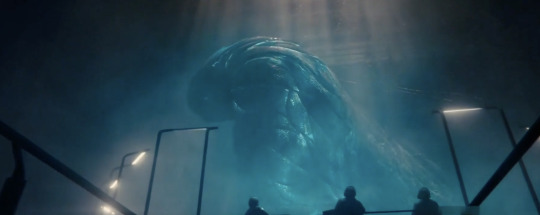
As Toho had done in SHIN GOJIRA, Godzilla’s roars from the various series were employed, as well as his roars from the 2014 film. I was hoping for more of the very deep vocalizations from the 1954 original. Mothra sounded as she always has, with plaintive chirrups and screes. The cries for both Rodan and King Ghidorah were not the originals, and were for me a bit more “generic giant monster” voices. I would have loved to hear new recreations of those readily recognizable Rodan yawps and cackles, and much more forward versions of KG’s triple toned “bidi-bidi-bidi” voice—rather than the faint references buried in the raucous sound design. I rather expected more original Toho monster sounds than were used for both of them, since Daugherty was employing past iconic sounds for both Godzilla and Mothra and seemed to be teasing that during the film’s production.
A Grim Setting
While there is some humor—not all of it apt— intended to break tension, the plot of this film builds upon the global revelation to the people of Earth that past super species were essentially their “gods,” knocking present day humans down a few notches on the dominance pyramid. The context is alarm and terror, though the MONSTERVERSE also offers awe and wonder as viewed through some of those studying the returning Titans. Serizawa remarks in a senate hearing that humanity should be viewed as Godzilla’s “pets”—and he means it. He respects “all forms of life” and sees our world as one that must have a balance which is inclusive of its natural organisms, regardless of where we might end up in Nature’s organic tapestry. Over the course of the film, much is learned about the fascinating past history of human societies who lived in harmony with the Titans. Toho implied some of this in their films—Mothra was regularly portrayed as an eternal goddess for the islanders she protected—but here it is made quite explicit and detailed. Godzilla’s temple lair in submerged Atlantis, with gigantic friezes and sculptures honoring him, is surely an enrichment of this ongoing saga. There is a dark side to this scenario wherein some see humans as being abusive to their world and thus in need of being forcibly “tamed,” and then there is the collective might of the military who want to subjugate these creatures and restore man’s preeminence—behavior that began in the original GOJIRA and sustained throughout most of the films.
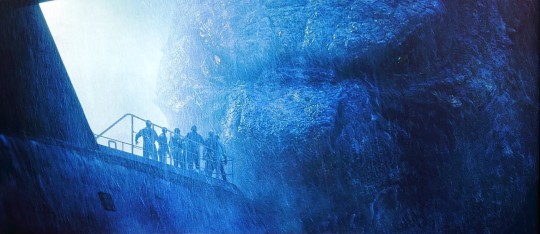
Dr. Emma Russell is an oddly polarized primary character. To begin, she seems a concerned mother who has rescued her daughter Madison from her husband’s descent into alcoholism, which had been incited by the death of their son Andrew during Godzilla’s San Francisco battle with the Muto’s. An aside: That plot aspect is reminiscent of a similar character motivation in the third of Kaneko’s Gamera trilogy, wherein a young girl’s commitment to invoking the destructive daikaiju Iris is sealed by her parents’ collateral death during a monster rampage in the first film where Gamera, an Earth defender, destroys his adversary Gyaos. That Emma is no “mother of the year” is quickly exposed when Allan Jonah’s eco-terrorists arrive to snatch she and her daughter (and her Titan controlling ORCA device) after they execute the innocent MONARCH crew studying Titanus Mosura. Emma has indoctrinated her daughter to comply with her pursuit of shattering mankind’s toxic presence by releasing the Titans as “antibodies” to the virus that is human kind. And Emma is in cahoots with these extremists, her obsession being the first cause setting in motion the slaughter of her MONARCH colleagues in China, Antarctica, and Mexico as well as the other locations wherein the Titans are roused to destroy their containment facilities. And countless others then perish around the globe as the revived Titans rage. The script makes her somewhat sympathetic as a mother—she is shown to love and be concerned with her daughter and mournful of her son—but one could not give her a pass for the oceans of blood on her hands. Nor should she be forgiven for making Madison a victim of Stockholm syndrome. Madison, comprehending the grievous practices kindled by her mother’s theories, does awaken to reject Emma’s deeds and then she strives at great risk to use the ORCA to solve the global catastrophe wrought by both Emma and Jonah’s fanaticism. There is a cut scene in the video release of Madison training with the eco-terrorists which would have underlined her submission to her situation—I would have included that for the parallel with Patty Hearst it presents. Madison ultimately is heroic, and her father Mark renews himself by stepping-up to guide MONARCH’s efforts to understand and control the Titans. He provides some crucial insights based on his knowledge of animal hierarchy and behavior. Ultimately, Emma seeks atonement through her sacrifice, which brings some justice to her character’s story, while Mark and Madison are reunited in a world reeling from cataclysmic destruction. A rather “heavy” arc to this family’s journey, and properly symbolic in dealing with present social concerns. I think that it seemed to be missed by many viewers who were more concerned with the pyrotechnics of the battling Titans, but for me it is a properly grounded human story which offers a grave context to the monster spectacles.

Homages A Plenty
There are so very many references in this film, both visually and via dialogue—“Easter eggs” abound! I’ll touch upon a very few, leaving exhaustingly listing them to other obsessive fans. I enjoyed the numbered MONARCH outposts having significance—the release year of the film in which the Toho daikaiju there contained was a delight and also the fun nod to THE THING in the Antarctica outpost numerical designation. Modernizing the Shobijin by having Doctors Chen and Ling, and generations of twins in their family, as “priestesses” of Mothra is an excellent touch. The new Titans are gleeful references to mythology and cryptozoology, demonstrating that many cultures have embraced daikaiju throughout history. Intriguing archaeological mysteries are touched upon such as 12,000 year old Göbekli Tepe, hinting at past humans dealings with Titans. Even an article in the jam-packed end titles is authored by Steve Martin, the character played by Raymond Burr in the American version of the 1954 film which was first to be titled GODZILLA, KING OF THE MONSTERS.
MONARCH’s mission critical submarine is named USS Scorpion, after an American nuclear submarine which was lost under mysterious circumstances, and it has a Captain Crane, like The Seaview in VOYAGE TO THE BOTTOM OF THE SEA. Its conning tower likewise has Seaview-esque planes and shape. The skeleton of Anguirus has a cameo, briefly glimpsed outside of Godzilla’s temple lair, and if only we’d gotten a better look at more of the Atlantean art paying homage to Godzilla—there seem to be monumental figures with Godzilla heads atop humanoid bodies holding some sort of ceremonial weapons which Serizawa passes on his way to revive his “old friend.” A sculpture of Pazuzu is glimpsed atop a step pyramid in that lost city—such artifacts all sadly obliterated to revive Godzilla. Some more time to drink in this elaborately detailed majestic setting would have been appreciated.

Several key plot events here are reshufflings from past Godzilla films. The concept of one daikaiju sacrificing itself to revive another was pivotal in GODZILLA VS. MECHAGODZILLA 2. There, Godzilla is tortured to near death by electrodes from Mechagodzilla which pierced his body and fried his secondary enlarged ganglial areas. Fire Rodan, nearly expired from his conflict with Mechagodzilla, as a dying act drapes himself atop the fallen Godzilla, evaporating into a sparkling mist and then both healing and resurrecting Godzilla, who now has an even more powerful, red-tinged plasma beam. In GMK, Godzilla is the “heel” who fights the more positive trio of Baragon, Mothra and King Ghidorah. Godzilla seemingly kills King Ghidorah, so Mothra makes a direct, suicidal flight at Godzilla who evaporates her with his plasma breath—shared imagery with Daugherty’s film, though here King Ghidorah and Godzilla have reversed roles. In Kaneko’s film, Mothra’s energy descends upon King Ghidorah in a sparkling cloud, reviving him and enhancing his wings and gravity beams for the final combat with Godzilla. That Godzilla thrives on exposure to radiation has long been part of the basic lore of many of the films, and his revival and enhancement through extreme exposure was no surprise as being primary to the MONSTERVERSE’s mythology. And the scene wherein King Ghidorah “powers-up” via biting electrical cables in the Boston battle reminds me of Kong being electrically revived in the original KING KONG VS. GODZILLA. Godzilla’s expression as King Ghidorah takes that bite, and then the massive arcs of electricity that spread out from his wings to clear the attacking human’s jets are both such memorable moments—which could have been given just a bit more time to accommodate earned “oohs and aahs.”

The novelization of GODZILLA: KING OF THE MONSTERS goes into detail about some of the Titans only glimpsed or simply listed in the film, and one hopes they’ll emerge in the next or further MONSTERVERSE installments—if any. There is a beautiful, brief passage in the book which is told from Godzilla’s point of view. We see through his eyes his responsibility as the lord and protector of this world—the globe is his domain and he is aware of the entire planet, sensing time passing through the shifts in Earth’s tectonic plates. He is aware of the much younger Kong, but unconcerned as Kong is only responsible for Skull Island. We know Kong is the last of his kind, and Godzilla also seems to be as well, though in the comic prequel to this film the story of the Godzilla-esque skeleton infested with the two Muto spores was explained as being Dagon—perhaps his elder “cousin”? The Muto which killed him was vanquished by Godzilla between the 2014 and 2019 films in that comic, which also serves to explain the change in his dorsal plates, which Dougherty has said are continually growing, like antlers. It would be a delight if the Kraken, snoozing as it embraces a sunken nuclear submarine, and Mokele-Mbembe, designed according to the legends as part serpent and elephant, had scenes in the films to come. If Godzilla at some point must sacrifice himself to save the world, discovering another younger member of his species in the Hollow Earth regions would not be surprising and would also embrace that “son of Godzilla” concept used in Toho’s series. The sunken Atlantis being part of the subterranean world evokes Verne’s JOURNEY TO THE CENTER OF THE EARTH, and of course the 1959 film adaptation concludes with a gigantic lizard menacing the remains of the Lindenbrook party in its ruins. Perhaps there are other humans (humanoids) “down below” as well, in fascinating antediluvian cities, much as Toho posited with the Seatopians, or even like the subterranean Sumerians from THE MOLE PEOPLE? Possibilities abound!
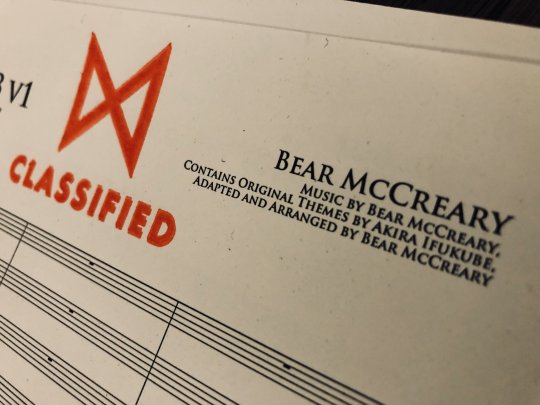
The Score
We’ve been quite fortunate that the scores for Hollywood Godzilla films have been powerful, thematic, and thoughtfully composed works wrought by talented composers. Both Arnold and Desplat crafted magnificent music that expressively carried the action. McCreary’s is the first MONSTERVERSE score to incorporate iconic themes for both Godzilla and Mothra from the Toho scores, and these quotations were well-timed and heightened the drama. Additionally, his new themes are both strong and memorable. The thematic material for King Ghidorah constantly iterates the number three, and the general rising melodic line is even kin to that of Holst’s “Mars, The Bringer of War” from THE PLANETS. The chanting monks’ voices offer a mysterious sense of religious awe to support the diabolical “destroyer of worlds.” Rodan’s theme features whooping horns, as if to echo the “Samurai of the Skies” cries. Even the film’s opening quiet theme has that “Go-Ji-Ra” rhythm that was used in both the 1998 and 2014 films to craft memorable new musical signatures for the King of the Monsters. Most touching was the gorgeous choral music accompanying Serizawa’s Spock-esque sacrifice—which even visually rhymed the descent of the mini-sub with the photon torpedo casket sequence from THE WRATH OF KHAN. The MONSTERVERSE’s Serizawa is essentially a transmogrified Dr. Yamane from the 1954 GOJIRA, a man who studies and appreciates Godzilla as a living being. By having him sacrifice himself not to destroy Earth’s dominant Titan, but to revive him with a nuclear weapon and thus save humanity, works as a pragmatic inverse linking him to the original Dr. Seizawa, the self-immolating physicist who conceived of far too deadly a weapon in the Oxygen Destroyer. McCreary’s “requiem” suited that sequence to perfection. When Godzilla rises again and blasts forth his plasma beam into the sky, the Ifukube-based accompaniment was deeply moving, and the moment Godzilla looked to his human saviors was delightful. He seems to acknowledge their role, much as that of the people from a past civilization who had idolized him, and the soundtrack even has a fleeting phrase of Ifukube’s Godzilla theme much as it was scored for high woodwinds in the requiem from GODZILLA VS. DESTOROYAH—a very brief and subtle nod. McCreary’s triumphant symphonic apotheosis of his own opening Go-ji-ra theme over that concluding acknowledgment of the Earth’s true monarch brought me chills. Being followed immediately by McCreary’s magnificently over-the-top arrangement of B.O.C.’s song “Godzilla” to commence the end titles was fan service of the highest order. Its refrain, “History shows again and again how nature points out the folly of man!” is of course the underlying theme of the Legendary MONSTERVERSE. “Bravo!” Maestro McCreary!

Could Be Bettered
Some minor cavils. I prefer to hear the word Ghidorah pronounced in the more euphonious Japanese manner, with the three syllables (ghi-do-rah) given equal emphasis and the first one slightly higher in pitch. One can hear it when watching Toho’s original Japanese prints with English subtitles. Americans emphasize the second syllable (Ghi-DOR-ah), and thus the middle one sounds like the English word door, while the Japanese put the R on the third syllable. I’d have dropped that weak gonorrhea joke, and the “very long fortune cookie” line was a tad clumsy, and a bit out of place for the dignified Serizawa. In this film he seems to take a bit of a back seat to Dr. Mark Russell, once he’s on the scene, which is a bit of a disservice to his character for me. And that his sidekick Dr. Graham is so quickly dispatched by King Ghidorah during his emergence seemed a bit too casual—her character was a fine one, and I’d have enjoyed more from her going forward.
The film brings back the Oxygen Destroyer, a wonderful nod to the original, and they hint at it being tested in the news crawl Madison and Emma have on in the background in their opening domestic scene at the China base. The news commentator’s reporting of “mass die-offs” must be from the military testing it. Rather than having it come as a surprise announcement when the incoming missile is announced by Admiral Stenz, I think that viewers should have been clued-in earlier, and rather easily. The audience primarily sees things from the point of view of the MONARCH characters. But if we go to that senate hearing scene, from which the MONARCH crew departs having been alerted to the eco-terrorist attack on their Mothra temple base—despite being warned that there will be consequences, that scene could have briefly continued. Admiral Stenz would reveal to the committee, once Serizawa and crew have departed, that the military now has a prototype weapon that they think could be used to exterminate the Titans. We’d cut from the blurred footage of the Mutos on the monitor to a graphic of the Oxygen Destroyer (what we saw later when Stenz alerts the Argo team), while Stenz declares this is their tested proposal for conquering the Titans. If one wanted to flesh it out, then perhaps running some brief footage of it killing fish or other forms of life with some dark accompanying music would be a strong punctuation. But even that wouldn’t be required, just that graphic and a Stenz voiceover would have done the trick. So, rather than ending on a weak joke about blurred Titan genitals, we’d have the Oxygen Destroyer’s revelation as added tension for its eventual use.

With such wonderfully detailed renditions of the Titans, particularly the four Toho guest stars, I think they went a bit too far in trying to fit them into their environments by surrounding them with clouds, mists, and fog. This gives the Titan scenes an overall soft and painterly feel, and I can enjoy that aesthetic choice, but seeing the creatures that were so very carefully designed, and whose movements are crafted in such a convincing manner, being obscured far too often I think was an error. Dialing that back somewhat would have been a wiser choice—show us what you’ve got! Particularly in the expert choreography of the battling Titans—which in some scenes appears to have been inspired by Matt Frank’s compositional style—being able to see how the tussles and tumbles progress with greater clarity would have enhanced the viewing experience.
Wishful Thinking
I would hope that there might eventually be a “director’s cut” in some future boxed-set home video release of the MONSTERVERSE films that would relax the pace of this film somewhat—taking time to linger on the beautifully crafted images so that we won’t have to freeze-frame to savor the glories on screen. And the storyboarded but unfilmed mid-credit scene of another Mothra egg being sung to by twin young girls in another hidden temple space beneath a modern city should be added-in or at least exist as part of the extras—possibly an animated version? If the box office returns from the next installment don’t justify further live action films, it would be fun to have a MONARCH-centered animated series exploring the numerous Titans and how humanity must deal with them. The cartoon series that followed the 1998 Emmerich GODZILLA film was quite an improvement over its progenitor, so I suspect something similar could happen with this franchise going forward once live action films are no longer produced.
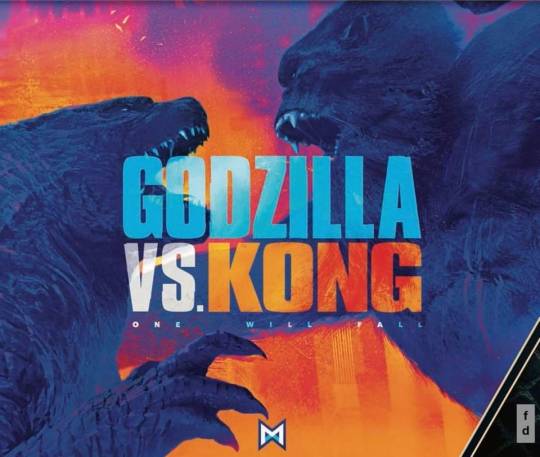
The Coming Conflict
Daugherty has reportedly had some plot input towards Wingard’s upcoming GODZILLA VS. KONG, and so the end titles give us glimpses into what might be to come via various briefly shown illustrated articles. One explains that the newly emerged Titans were being drawn to Skull Island, so one has to wonder if that locale could at the conclusion become the “Monster Island” of the MONSTERVERSE? That it is a gateway to the Hollow Earth is an exciting prospect, for more mysteries abound there. Already the rumor that the APEX corporation, which funded Colonel Alan Jonah’s eco-terrorists, is now behind the construction of Mechagodzilla (the toys of this character have been leaked already), who will have an ORCA variant built-in to lure Titans to the slaughter.
King Ghidorah can regenerate in an unearthly manner and the director has mentioned in interviews that his consciousness is spread through his body. Daugherty has said that whatever might have fed on the carcass head could perhaps become some sort of mutating “legion,” perpetuating King Ghidorah, from flies to any sea creatures that took a nibble, if the series goes on. The rumor mill suggests that materials from the brain of this dead head have been used to create a bio-tech controller to enhance Mechagodzilla. Now that we’ve gone to a Showa series sensibility, the film makers have a great deal of latitude for referencing some of the more fantastic concepts from earlier films. With the biggest blockbusters today being super hero fantasies, one need not try to pretend that MONSTERVERSE films are bounded by the laws of our Universe. The relatively more “realist” approach of Edwards’ 2014 GODZILLA has been evolved into a broadly fantastic approach, which reflects much of what Toho had done in all of its series.
Fan Reactions
It seems some Godzilla fans on message boards are now turning on Dougherty’s epic—everyone seems to want each new film to be their vision of the perfect Godzilla film and then disappointment sets in when it isn’t. Yet so many of the films throughout the ongoing saga of Godzilla have been silly, cheesy, daffy, and sometimes just dopey—yet many of we aficionados embrace them all for their charms, after all, we get to see more of Godzilla and his fellow daikaiju. They appeal to quite a wide range of viewers of all ages, and as one ages, different films might head a favorites list based on one’s evolving tastes. Better that more Godzilla tales are wrought and released, regardless of whatever flaws we might find. In GODZILLA: KING OF THE MONSTERS the incarnations of our old favorites and some intriguing new Titans are truly extraordinary, brought to vivid life with contemporary effects capabilities. Never before have these sorts of films been graced with such mammoth budgets and been seen by such large audiences around the globe—a golden age for Godzilla is upon us.
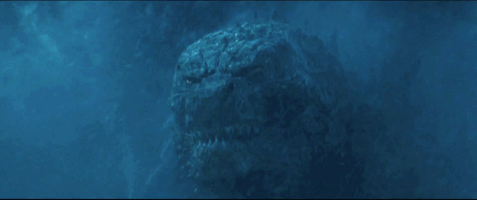
Huzzah Daugherty!
Despite its flaws, I find so much to love in this film, particularly that final scene. After Godzilla has vaporized his age-old rival and literally “smoked” his final head, the Titans summoned by Madison’s activation of the ORCA in Fenway Park arrive. Godzilla, battered and weary from his strivings has exhausted the energy gifted to him through his ally Mothra’s sacrifice—like Heracles after his many labors. This unbowed victor is at last confronted by the other awakened super-species. It looks like a further battle could ensue, as Rodan swoops down at last. But, that canny firebird knows his place and thus submits to the true king, with a nod and almost a courtsey-like gesture of his cape-like wings. The other Titans then “bend the knee” and Godzilla bellows his triumphant “skreeonk” as McCreary’s music superbly supports this coronation scene. I felt such a powerful frisson at that moment and do with each repeat viewing. The Titans demonstrate their consciousness, intelligence, and their sense of natural hierarchy in what is one of my favorite conclusions in the entire canon of Godzilla films.
So, I salute Daugherty and all the others involved in what for me is a grand outing for all of the Titans and a very fine addition to the roster of Godzilla’s adventures. I’ve watched it many times since I saw that first Thursday night preview screening, and I continue to enjoy it immensely. Like all of the earlier films, I don’t dwell on what I see as flaws, but I celebrate the unique wonders that have been wrought, and these abound in this Toho-redolent GODZILLA: KING OF THE MONSTERS.
The bar has been raised. Batter-up, Adam Wingard—let the MONSTERVERSE continue!
—Peter H. Gilmore
19 notes
·
View notes
Link
1. Pfff
It might sound (and look) a bit silly but this word is a staple of French conversation and used in the right way, it will give your spoken French a bit of native attitude.
Pfff often goes hand in hand with a facial expression that exudes boredom or dislike because it is used to convey contempt, disdain and scorn.
The French use it when somebody is saying something they consider to be stupid, ridiculous, pathetic so much so that they are at a loss for a real answer and are reduced to saying pfff.
There isn't an exact translation in English, but it could be compared to sighing loudly when someone is speaking and some might even make a similar noise to the French pfff to go with it.
Here's an example of this noise in use: Pfff, elle n'avait rien d'exceptionnel cette femme. - Pfff, there was nothing exceptional about that woman.
Or, Pfff, c'est n'importe quoi - Pfff, whatever.
Remember that while it is very common, it is still colloquial and is certainly one to avoid using in front of your boss.
2. Aïe
Aïe is a sound you will hear a lot around France and it may be one that moves you to ask the person who utters it if they're ok.
The action that goes with this word is a deep frown or perhaps even a wince of pain, because it is the French equivalent of 'ouch!' or 'ow!' in English.
So for example you might say: Aïe! Je me suis piqué le doigt. - Ow! I pricked my finger.
Or Aïe! Aïe! Aïe! Je viens de me couper. - Ouch! I just cut my finger.
It can also mean 'oh', 'oh dear', 'oh no' or 'oh my'.
In this case, you might say: Aïe! Que se passe-t-il? - Oh my! What's happening?
3. Bah
Bah will make you sound as French as the French, particularly if you deliver it with your eyebrows raised, your hands turned palms upwards and your mouth formed so that both corners are pointed to the floor. Or with your eyes wide open and an expression of complete perplexity.
Bah can mean ‘I know everything' or ‘I know nothing', it all depends on the delivery and context.
Say it quickly and you can sound dismissively confident. However, you can also say it quickly to sound genuinely surprised. It can also be stretched out to demonstrate just how sceptical and incredulous you are. Or indeed how dubious you are. Everything depends on your facial expression.
Baaaah oui.... 'But of course, you are a fool for asking this question'. Or 'I think so….' (showing your hesitation)
Bah oui! 'Yes!' (showing the answer is blatantly obvious)
Bah oui? 'Goodness me! Is that really true?'
4. Ben
This is one of those French words that you're unlikely to be taught in school and it can really throw a spanner into the works when people start using it in informal conversations.
And if your name is 'Ben' then you're even more likely to be confused... particularly when you see it written down.
But the main translation for Ben isn't exactly a word.
The equivalent in English would be 'er' as in the noise you make when hesitating or playing for time at the beginning of a sentence.
For example, Et tu sais à quelle heure revient ton frère? - Ben, j'en sais rien. (And do you know what time your brother got home? - Er, I don't know anything).
If you're surprised it can also mean 'well'.
Or, J'ai gagné €10,000 à un jeu à gratter! - Eh ben, t'en as, de la chance! (I won €10,000 on a scratchcard game! - Well, you're lucky!)
It can also translate to 'of course', such as Et tu vas à l'anniversaire de Pascal samedi? - Ben oui! (And you're coming to Pascal's birthday on Saturday? - Of course!)
You could also say Ben ça alors! to mean 'well, well, well!'
5. Blow a raspberry
Difficult to spell, this is the noise that babies make when they blow out their cheeks, or the noise of someone making a farting sound.
Unlike in British and Americans cultures, though, in French this is not rude, it's simply a way of saying 'I have absolutely no idea'. It can be used as well as or instead of a shrug if you've asked something that is simply impossible to answer.
6. Hein
French speakers pepper informal conversation with hein all the time. It's one of those things that no one teaches in school, but will make you sound a lot more natural when you talk.
Hein is an interjection which is used to pose a question or seek confirmation. It is usually found at the end of a phrase, but also sometimes at the beginning or on its own, and serves a number of different purposes.
Hein?, when it's on its own or at the beginning of a phrase, is very similar to the English ‘huh?' or ‘what?', used to indicate that the speaker has not understood something and would like it to be repeated. As in, Hein? Qu'est-ce que tu as dit? - ‘Huh? What did you say?'
And just like ‘what?', hein? used in this way can also indicate the surprise of the speaker, rather than that they have not heard what the person they are talking with has said: Hein? Tu as déjà fini? - ‘What? You already finished?'
It can also be used to insist on a response, even when the speaker may already suspect that they know the answer: Pourquoi est-ce que vous êtes en retard, hein? Vous êtes réveillé tard ? - ‘Why are you late, huh? Did you wake up late?'
Or to simply solicit the agreement of the listener, like ‘eh?' or ‘right?', especially at the end of the phrase. For example, Ce n'est pas si facile que ça, hein? - ‘It's not so easy, right?'
Finally, hein can be used at the end of a phrase to emphasise what has just been said, as in Laissez-moi tranquille, hein! - Let me be, ok? (In this case, no question is actually being asked).
However hein is used, it's usually in an informal context, and is the kind of filler word you want to avoid in presentations at work or school.
7. Kif-Kif
This informal phrase will help you out when comparing multiple things that are more or less the same, or when you want to make someone believe that that's the case.
Kif-kif means ‘it's all the same', ‘it's equal', or ‘it makes no difference'. This phrase is usually used in informal scenarios to compare two options that are so similar that they are virtually equal.
For example, Si je prends le métro ou le bus, c'est kif-kif, ça va durer une demi-heure (Whether I take the metro or the bus, it's all the same, it's going to take half an hour).
It can also be used to indicate that two parties have contributed equally to something, especially expenses: Tu as payé le dîner? Non, on a payé kif-kif. (Did you pay for dinner? No, we split the bill).
In this case, the term moite-moite or moitié-moitié (half and half) can also be used.
8. Bof
If you're feeling demotivated, indifferent, or want to engage in the traditional French pastime of avoiding being positive (being honest) about things, this is a need to know word.
Plus it's a French classic, right up there with pfff, exaggerated shrugging and oh la la.
Historically it's thought that this word might be linked to the acronym of Boeuf, Oeuf, Fromage. All three foods were rationed during the German war-time occupation in France and black marketeers became known as BOFs. Overtime bof has lost this unscrupulous association and come to mean something quite different.
Bof is a spoken interjection that translates more as a feeling of disinterest or mild unhappiness than an actual word.
It's nearly always used as an indifferent or slightly negative response to a question, for example, - Que penses-tu de ce film? – Bof. Pas terrible. (What did you think of the film? – Whatever. It wasn't terrible.)
Similarly bof could also be the response to ‘Don't you think the film is great?' (Tu trouves pas que ce film est génial?) or ‘Do you want to go to the cinema? (Ca te dit d'aller au cinéma?), meaning an apathetic ‘not really' in both cases.
It could also be a slightly depressing reply to ça va? meaning ‘not great', ‘ok', or ‘meh'.
Considering that a normal reply would be ‘fine' or ‘good thanks' (bien, merci) saying you are just ‘alright', ‘ok' or bof actually implies that you feeling a bit miserable.
Finally, if you're going to use this classic French sound you might as well go the whole hog and Frenchify your gestures too; bof is often said with an indifferent expression and dismissive shrug of the shoulders.
9. Oh la la
And let's finish on a French classic. Any caricature of the French involves someone saying Oh là là and the best thing about this cliché is that it's actually true.
Living in France you hear it at least once a day, probably more, and after a while you find yourself saying it almost as much.
There are several meanings for Oh là là and to work out which one you're hearing you'll need to rely on context.
One important thing to note is that unlike in English (when we say 'Ooh la la') when the French use this expression it is never intended to express that someone is sexually attractive.
Here's a look at the different ways it is used.
There is the 'traditional' method, most known to foreigners and often (though not exclusively) used by women, which is the prim and proper Oh là là. This is used to express admiration, almost in the same way we anglophone girls of a certain age use the phrase 'Oh my god'.
For example, you show someone your new ring and they say Oh là là c'est trop jolie! (Oh my god it's so pretty!). It is high, light and happy. This is a good Oh là là.
Then there is the bad Oh là là. Perhaps predictably, the French often employ the bad Oh là là, used more in the sense 'Oh my god that's freaking annoying'. .
For example: a car burns through a pedestrian crossing nearly knocking you over or just doesn't stop to let you cross the road generally or the cashier at the supermarket tells you je ferme ma caisse, moi (I'm closing my till) even though the queues are huge.
This Oh là là (or even Ho là là) is low, baritone and disapproving, often muttered under your breath.
Then there is the pièce de la résistance (which, incidentally, is not something the French say. Go figure.) - the Oh là là là là là là. Yes, that's right. Six “là”s - no more, no less - in quick succession. This is bad. This is very bad. Not to be bandied around lightly, this is reserved for those head-in-hands, all hope is lost kind of moments which, again perhaps unsurprisingly, happen in Paris more often than you think.
This is used when the French miss a crucial goal in the (soccer/rugby/other ball sport) or when you get halfway home from CDG and realise the cab driver doesn't take carte blue.
327 notes
·
View notes
Text
Stray Cargo
Fifth installation of The Hearteyes Zone, a supernatural series of one-shots.

You’re spiraling into the unknown, a universe of anti-possible happenings and unique incidents.
A cruise ship called Carousel is on its way from the Bahamas with a peculiar stowaway on board. What manner of intruder is this, you ask?
One summoned by loneliness.
When desire calls to the sea, sometimes the sea will answer...
If you're in the Hearteyes Zone.
—–
“Okay, shake it out! Good job everyone, this next dance is called the Cha Cha Slide! If you know it, prove it and come on up to the front. Dancers to the front! We have one, two, four, six, seven eight M’s in our bank account. What?! In our bank account! I’m kidding! People from the crowd. Nine. You sir, I see you, you know you wanna dance! Come on! Ten, thirteen-fourteen-fifteen, ALRIGHT DJ!” The music scratched switching from Wild Thots and Lyric led the mixed crowd in the infamous urban line dance as bystanders screamed their support and filmed, likely to post their loved ones’ dancing skills or lack of on social media.
This is something new, the casper slide part two, featuring the platinum band.. and this time, we’re gonna get funky!
The music blazed through the speakers as people of all ages, languages, and races danced and hopped for the crowds who watched from all floors of the boat, cheering and dancing in place. This was the same celebration that happened every other night.
---
Despite the late hour, the pools were open and movies played on giant screens. Food still flowed and passengers still roamed. Lyric was exhausted, run down, and partied out, but on the Carousel ship.. the party never stopped. Tomorrow she'd have to get up and do it all over again. She had signed on for eight months of customer service and parties pretty much and it had only been three. She couldn't sleep in, there were no days off, and she missed her mother. Although she was surrounded by crew, they weren't her family.. they weren't her friends. Also, American staff members were rare.
Lyric was lonely.
She did share a cabin with a Spanish crew member by the name of Lydia but Lydia was barely in the room since she dated an officer who had his own room, something Lyric never complained about. It was the only privacy she got.
Tonight Lyric decided to use the alone time to masturbate which only made her hungry, so she redressed and left the cabin to buy a snack, a coke and some chips. On her way back she heard strange knocking coming from a crew members only door, pausing to listen. "Hello? Someone stuck?" It stopped and there was a thump and scratching. The scratching got louder and more urgent. “Hello?”
When no one spoke, thoughts of demons, movie monsters, and serial killers flashed in her mind but reality kicked in. She was on a boat. Who kills on a commercial cruise? Shaking her head, she took a breath and twisted the doorknob finding a large rednose with an aggressive glare.
She took a step back. It was a muscular dog and she didn't know its temperament or anything about it including how it'd gotten on board. It stood, walking casually as she froze, not wanting to present herself as a threat. She didn't know what to do. “Are you… hungry?” It yawned sitting beside her and she took a look around. There was no one in sight, but someone had to have closed him in there. She dropped a chip on the floor and he stood wanting the bag. "Oh, okay, o-okay," she wavered nervously as he jumped, letting him take the bag. She gently reached to scratch his ear, relaxing when he leaned into her accepting the rub. "Aww," she smiled. "You look mean as hell! But you're just a cutie.. Where did you come from? Huh? Huh?" She was baby talking the dog and completely unashamed.
---
In the cabin, Lydia was still away. There was an unused paper bowl in the neat room that she used as a dish to pour water into and he went to it, lapping it to the point where she had to refill it. Where would he pee? She had to think of something. "We need cardboard.. newspapers.. something so that you don't pee and poop on the floor... Stay," she pointed as she backed out of the cabin to locate materials. She practically ran back to the room setting up a makeshift bathroom before climbing into the small bed to go to sleep. Tomorrow would be another long day. She noticed the pit climb into the second bed, curling in to rest. Lydia wouldn't be back anyway, Lyric thought, what did it matter? "Goodnight, pup," she whispered closing her eyes.
---
After an early breakfast, Lyric snuck some meat back to her cabin where Lydia sat. The dog was gone, Lydia was there, and the newspaper was still dry. "Lydia, did you see... a dog?"
Lydia gave a confused look in return. That was a no. Where had he gone? How? She didn't have time to look for him, it was time for the first class of the day. After this, she'd be teaching 70s dance.
There was a designated part of the boat she reported to where The Second Waltz by Dmitri somebody played and she demonstrated the box step with one of the passengers, the most common foundational step in many dances. She wore a blue flowy dress and low heels.
"We move around the room in a counter-clockwise direction and he guides me," she stopped. "But first, you begin side by side, left foot forward, one. Step to the right with your right foot, two. Left meets your right foot, three. Step back with the right, four. Side left, five. Close with your left foot, six... GOOD JOB ERIK, you're a natural," she smiled up noticing his dimpled smirk. He was a talented volunteer.
"I try," he shrugged and Lyric hated so bad that she wasn't allowed to fraternize with the passengers. It would get her fired instantly. She hid her interest and looked back to the group of learners, waving for her handsome volunteer to rejoin the group. "Okay, here we go! Count with me."
---
By the time she was done four separate lessons, she needed a break and something to eat. Then it was back to the room to see if her four-legged friend had returned. He came mosying down the hall shortly after her to her surprise. "C'mon," she patted her knee for him to hurry so she could conceal him inside of the empty cabin. She rubbed him down and he hopped onto her bunk lying down on her blankets. "I see you didn't use the cardboard or newspaper I set up for you last night," she pointed out. "You didn't have to go?" He caught her on her lips with his excessive licking, effectively ending her questioning and sending her to the tiny bathroom to wash her mouth. "Are you hungry?" She tossed him the meat she'd brought earlier and he sniffed it not eating it. She laughed. "You're such a bougie pup, don't think I haven't noticed you don't eat from surfaces, only from my hand, a dish, or straight from the bag. You must belong to someone with a lot of money, someone who spoils you rotten." A lightbulb went off in her mind. Someone snuck their pet onboard. "Who was it? Who do you belong to, boy?" He rolled over on the small bed exposing his stomach and she rubbed it vigorously. "Yeah you're definitely a rich person's dog. So spoiled!"
Lyric had to go back out for dinner, to dance, and to work the mic partying professionally for the rest of the night as entertainment, but when she returned to the cabin with Lydia the pit was there on her bed sleep where she'd left him. Lydia jumped at the sight, whispering. "There's a fucking pitbull on the bed!"
"I know! Don't snitch," Lyric whispered back sitting on the bed to rub the sleeping dog's back. After her shower, she had to push him aside to climb into her narrow bed. Lydia was in her own bed. He climbed back up curling up in the gap of space he could find. "So spoiled," she yawned falling asleep.
---
Another day. Lyric had to do this for about five more months, but this was the last day onboard for this particular group of passengers. Lyric looked to the cardboard and newspaper. It was still empty and dry. What was wrong with this dog's bladder, she wondered looking over at the large dog on her legs. She sighed thinking of how once the pup returned to whoever he came with, they'd leave taking him with them. She rubbed his back and as if sensing her sadness, he licked her a Good Morning. He was her only real companion on that boat and the only connection she'd really formed. She tried to follow him to find his owner to greet them and tell them what a hit he'd been, but she'd gotten distracted and lost him somehow. He was such a mysterious little blessing.
It's just a jump to the left. And then a step to the right! With your hands on your hips. You bring your knees in tight! But it's the pelvic thrust! That really drives you insane! Let's do the Time Warp again! Let's do the Time Warp again!
She went through dance after dance after dance and each time she had to be personable, bright, and energetic. Out of the repeat students to show up for the various classes.. that one guy, Erik stood out always helpful and always sweet. She'd miss him too.. and if she weren't a crew member and could just cruise as a guest, she would be all over him... but alas. He had to go. Her pup had to go. She'd be alone again.
---
The boat was set to sail back to Florida from the Bahamas in the night, a trip that could take up to 10 hours. On schedule, the boat shook, signifying that it had been undocked and was beginning its voyage back to the starting point. Lyric had just settled into bed after a strenuous night. Pup was gone, Lydia was sleeping with her officer boyfriend, and Lyric was alone in the room. As the boat sailed, she could feel the movement. Her heart clenched and a tear fell from her eye and she wiped it quickly. She couldn't believe she was crying over a dog that wasn't even her dog. It was more than that.. She felt the harsh loneliness creeping back in quickly and she couldn't take it. She closed her eyes willing herself to sleep to stop from feeling. It worked because when she woke up, it was to the sound of the bathroom door opening after a toilet flush. Lydia. She didn't feel like getting up but she finally opened her eyes checking her watch.. It was time to shower and get her breakfast. Turning over with a sigh her eyes focused on a large body resting on the opposite bunk.
A man.
She screeched, jumping up and snatching the covers from him. She gasped as he stirred opening his eyes to focus on her slowly, eyes full of a warmth that melted her.
"Erik?"
He looked down at himself in confusion, sitting up and she took a step back. "My bad," he grumbled, voice low.
"Why are you in here, I could get fired," Lyric fussed. "How did you even get in here?" She looked around confused. "On God, you better start speaking. I swe-"
"Hold up, I was hella lit last night," he groans rubbing his face. "So, I ain't make it back before you fell asleep, but I just wanted to say bye. I'm a miss you." With that, he shifted and Lyric nearly pissed herself as she stared at her beloved pup sitting on the bed watching her. Covering her mouth in shock, she fell back into her bed, her heart racing and body trembling. Coming nearer, the dog jumped up to lick her and suddenly she felt strange petting him. He was a grown ass man in her bed.
He licked her face, jumping on her hard enough to push her back and she froze, eyes wide. He shifted back into a man, his hulking body over hers and her heartrate spiked again. He laid his head on her chest, not moving until she calmed down.
When her heart slowed, he sat up adjusting his clothes and she wondered how it worked. How did he shift and still have on clothes? "In movies when werewolves shift back into people, they're always naked," Lyric spoke wide-eyed.
"...Did you want me to be naked?"
"Maybe... I don't know, this is weird," she frowned flinging her arms.
His brows rose.
"Mama is a pervert yet I'm making this awkward," he smirked with a hesitant pause. She was still staring, following his hand as he slowly moved it to his zipper. "If you promise not to cry when I leave... I can make this goodbye a little sweeter for you," he muttered stripping off his clothing peice by peice as Lyric stared on. He stopped when he was nude. "Now you only thinking bout one thing..."
Placing her hand on his erect shaft, he squeezed it around him "Rub this dick like you rubbed my stomach." She snickered and he guided her hand as she jerked him.
"I hope this isn't beastiality," she whispered putting her mouth on it. She drew him in, swirling her tongue around the head and sucking. The sloppier she sucked, the harder he gripped her head into his abs trying to push himself down her throat.
She came up with a loud gasp for air, spitting onto his shaft, drool dripping down her chin and he flipped her onto her stomach, pulling off her panties and using her arousal and her thick spit for lube.
"Open up." Pressing into her from behind he started rough off the bat giving her no time to adjust to him. She buried her mouth into the bed with her ass high, her body pushed forward by his rough thrusts. She hadn't gotten dick since she'd stepped onto that boat and she almost cried from how much she missed it.
His hands wrapped tightly around her neck and it was like he was taking out anger, slamming into her guts as he choked her, her face turning colors, pressed against the mattress. He growled in her ear and the guttural noise triggered her vagina to squirt. He wanted badly to be remembered.
"I'm come-," she whispered and it was inaudible to her own ears.
"I'm fucking this shit up, like a good boy.. ain't it?" He chuckled and she felt as though she'd pass out, she was so far gone.
"Good boy... Say it," he commanded in her ear, breathless. He loosened his grip so that she could speak and she panted catching her breath.
"Good boy, Erik," she moaned through heavy breaths, her pussy tightening. Her whole body tensed before dropping and he closed his eyes to enjoy the feeling of her squeezing against his girth.
"I am a good boy. Top dog and you my bitch," he muttered, pulling out to fire on her asscheeks. He collapsed on the opposite bed, grinning before wiping her cum off oh his thighs and dick. "I gotta make sure they got my bags and get outta here... BUT," he stood rubbing her back. "I won't forget you. Maybe we'll meet again sometime. You never know." He opened the door and shifting back into his pitbull form
...He was off.
@muse-of-mbaku @imaginewhoever @whoramilaje @panthergoddessbast @thadelightfulone @misspooh @inlovewithmakeupcomicsanimelove @marvelpotterlove @youreadthatright @forbeautyandlife @theunsweetenedtruth @bidibidibombaclaat @myboyfriendgiriboy @dameshaemonique @blackpantherimagines @vikkidc @hidden-treasures21 @mysidefanting @allhailnjadaka @hold-me-like-a-heart-beat @syndrlla97 @winteroflife @thotyana-in-this-hoe @texasbama @gingerylimonte @princessstevens @magic-madness-heavensin @taint3dvirgin @wawakanda-btch @scrumptiouslytenaciouscrusade @wakanda-inspired @blackgirloneshots @thegucciwaffle @thiccdaddy-mbaku @ledouxange7 @drsunshine97 @purplehairgawdess @trevantesbrat @indigoxsummers @cccccx1 @dynastylnoire @iamrheaspeaks @blowmymbackout @fonville-designs @they-call-me-le @theblulife @raysunshine78 @sheisexcellent
#erik killmonger#original#erik stevens#killmonger#erik killmonger fanfiction#erik stevens au#erik killmonger smut#killmonger smut#killmonger fanfiction
107 notes
·
View notes
Text
Does Classical Music Deserve a Reprise?
Classical music itself is a tricky term. To most, it’s an umbrella term used to describe music you associate with grand concert halls, orchestras, and composers such at Beethoven and Mozart. To those with musical literacy, however, it’s a specific period of music that started in the mid 18th century till the early 19th century. But, that is not the point of this article. Today, let’s use the term to refer to what most people think of when thinking about Classical music. It’s old, it may even be boring, but more importantly, it’s dying. Concerts are receiving less government funding and the audience is somewhat depleting.
The Audience Agency’s report on UK’s classical music audiences that covers classical music events from 2014 to 2018 demonstrates that the average age for Classical music is increasing. Like how several countries in the world are battling the problem of an ageing population, Classical music is too. But why is this so? Is it possible that Classical music events are just catered to the older generation? People above their 40s probably have more disposable income, more leisure time to attend concerts and are more interested in investing themselves in cultures that nourishes them beyond having Instagram worthy content. Maybe it’s possible that the lifestyle that comes attached to the Classical music scene is more suited to the older generation, but I’m guessing there’s more to it.
So, is there something about Classical music itself that puts off the younger generation? If we look at the music listening habits of the younger generation, YouGov, in a survey commissioned by the Philharmonic Orchestra, younger people do in fact listen to Classical music. Some listen to it by choice, like when studying, and some when they happen to be at a social event that has it on loop in the background. With Spotify dominating in the music-streaming sector, they too offer a wide range of Classical music. From having artist profiles of composers such as Beethoven, Mozart, Tchaikovsky and more, to creating playlists of Classical music streamers can tune in to. In 2018, streams of Classical music rose by 42% according to an article I came across published by The Guardian. Furthermore, with the rising popularity of film music, the younger generation does in fact engage in some form of Classical music, even if it’s just tracks of Hans Zimmer on repeat.
However, looking at the numbers now on Spotify itself, Classical playlists only have the smallest fraction of listeners compared to other more popular genres of music. Again, I’m asking, why is this so? Maybe it’s the fact that it’s instrumental and the younger generation needs lyrics to relate to the music. But I’m sure if they gave it a chance, they will find how moving Classical music can be. In saying that, I do need to admit that I am a millennial who listens to Classical music, so I may be a tad bit biased. If I think about myself, the reason why I got into Classical music is simple—I grew up singing in choirs and I’m now studying Music in University. This then brings me to the idea that perhaps, Classical music has a sense a exclusivity to it. Do people feel like they need to be part of this imagined musicians-only sphere to appreciate Classical music? Do they feel they need some level of musical literacy to even begin listening to it? Perhaps.
Going back to live concerts, I feel like I can describe the audience pretty easily and this is based on my personal experience as well, both as a performer and an audience member. If I look around a concert hall, it’s filled with people that belong to one of these three main categories. First, they are friends and family of a performer on stage. Second, they are frequent Classical concertgoers, the so called connoisseurs. And if they belong to the second category, they most likely fall in the third and last one too—the older generation. So again with the question, why does the younger generation not want to give Classical concerts a go? I’ve asked a few of my non-music University friends before and most of them shared the same sentiments. They never saw the need to, didn’t know how to and just never thought about it in general, assuming it wasn’t “their thing”. With the misconception that Classical music concerts are for the upper classes, costly, maybe even boring, and not forgetting how some still think they need to show up in black-tie appropriate outfits, I see where they are coming from.
Now, you might be thinking—the younger generation may not attend the concerts, but at least more of them are giving Classical music a shot by simply listening, so what more am I asking for? There’s a difference between streaming a piece of music and watching it live, and I believe most can agree with me when I say that this applies to all types of music. Just walking into a concert hall and seeing a full orchestra in front of you is an experience on its own. This brings me to my final questions. If Classical music was able to survive over a thousand years, why should it die now? If concert-going behaviour is still thriving in the pop music industry, why should Classical music concerts die now? More importantly, how can we help make Classical music and related events appealing to the younger generation to keep it alive?
There are three names that come to mind when I think about that last question. First is Lindsey Stirling, an American violinist, singer and songwriter. She is known for her choreographed violin performances of classical, pop, rock and electronic dance music. 11 million subscribers. Second is 2Cellos, a Croatian-Slovenian classical trained cello duo. They play instrumental arrangements of well-known pop and rock songs, as well as classical and film music. 4 million subscribers. What Lindsey and 2Cellos have in common is that they do use Classical instruments in a pop context or at least one that “spices up” Classical music. Yes, they show what a Classical instrument can do and try to make it more relevant today, but I can’t help but dwell over the fact that their covers of popular music have more views than their Classical performances. Do we really need to forgo centuries of tradition and integrity just to make Classical music relevant again? And if we do re-contextualise Classical music to fit into the modern day taste in music, are we really doing it justice or simply finding ways to force it down people’s throats? Please forgive me for being crass, but I think that’s just the easy way out and dare I say it, sell-out. Don’t get me wrong, they are amazing at what they do and there is no doubt that they have talent, but I think we need other ways to re-introduce Classical music today.
This then brings me to our last case study, TwoSet Violin. Made up of two classical trained violinists, this duo are the faces behind a Youtube channel that has gained over a million subscribers in a few years. Their content revolves around skits, react videos and games incorporating the violin. Some of their most viewed videos are those funny and sometimes painfully accurate ones portraying the life of a Classical musician. You may think, isn’t this still exclusive to people who are musicians themselves? Yes, you are right, but let me tell you about what they achieved in recent years.
Their mission is to make Classical music more accessible to all and with that, continue to inspire the next generation. They did exactly just that with their unique take on a Classical recital. In 2016, TwoSet Violin gave up their respective positions in Sydney and Queensland Symphony Orchestra to host live Classical comedy performances. They created a show which offers an experience, one that integrates humour with actual recital, while still upholding the integrity of Classical music. I never gotten the chance to watch them live, but after scrolling through videos and reviews on various news platforms, I saw how they managed to attract a diverse crowd, one that includes the younger generation and one that includes those who have never been to a classical concert before. From 2017 to 2019, their efforts were channelled into their world tour. With each show, they put in effort in making each one unique, tailoring their show to suit each culture and audience. None of their performances were the same. It is also worth mentioning that it was the first ever crowd funded Classical world tour. Through this, they managed to show that Classical music need not always be dependent on government funding and the typical concert-going demographic, and more importantly, people are willing to give Classical music a shot if you give them a reason to.
We started this article talking about the ageing audience of Classical music concerts and how we may witness the death of Classical music one day. It is safe to say that interest in Classical music is dwindling, be it in terms of concert-going behaviour or listening habits. I, however, have hopes that that day won’t come, or at least not as soon as we think. If we think about how we can “rebrand” Classical music and its related events, without compensating on the quality of it we admire, I believe that a wider audience, including the younger generation, will give it a chance.
Here’s my take—just like every other genre of music, Classical music may not be for everyone, but I urge you to give it shot. Give it try outside of using it as background music when you study. Maybe even attend a concert one day to experience the auditory and visionary spectacle for yourself. I can assure you that you don’t need any level of musical knowledge to listen to and maybe even appreciate Classical music, you just need your ears. You never know where listening to just one piece will take you because in Classical music itself, there’s so much to explore in terms of genres and forms. And if you do give it shot, but still feel like it’s not for you, that’s perfectly fine. I’m just one person and what I do won’t make much of a difference, but I guess this is just my little way of trying to keep a part of history alive.
2 notes
·
View notes
Text
#863: ‘The Last Seduction’, dir. John Dahl, 1994.
Well, the mid-90s were certainly a weird time for filmmaking. This film is one of the temporary resurgence of the neo-noir in American filmmaking, when the rigid gender policing was less enforced and filmmakers were more interested in dissecting the role of the femme fatale. Most of these films have fallen out of popular favour because, for them, ‘dissecting the role of the femme fatale’ meant ‘make a sexy woman who the male audience will find attractive because she can crush your gonads with a cold gaze, but it’s okay! She’s fictional’. These films have not really grappled with the female character on a deep level, is what I’m saying. Sadly, despite some whip-cracking dialogue, The Last Seduction is no exception. I was willing to go along with its absurdity, but the film decided to take a hard turn into the weeds at the end and I just refused to follow it.

The Last Seduction had a lot going for it: Linda Fiorentino as the femme fatale, Bridget Gregory/Wendy Kroy; Bill Pullman as her devious husband, shrugging off his usual role as the dependable father/President; Peter Berg as the well-meaning schlub who quickly becomes Bridget’s target. All these actors have great agility within their roles, and in the case of Fiorentino, if she hadn’t been immediately typecast as the ‘sexpot’ (to quote most synopses of this film) she would have been pretty effective in most comedy hybrids throughout the decade. She could more or less have taken the same career trajectory as Anjelica Huston.
These three are working in the confines of a plot that beggars belief, though. Bridget steals the money from her husband’s heist, and moves to a small town where she immediately grabs hold of Mike (Berg), quite literally, and tries to sway him to kill her husband. In doing so, we learn a few things about Bridget: she’s cunning, she’s amoral, and she has a neat party trick in that she can write legibly, both upside-down and backwards. This last fact is repeated so often in this film that it is the only reason that the plot actually lifts off: Clay (Pullman) discovers Bridget’s alias as a result of this.
Before I go further into detail here, it’s worth raising the concept of limited diegesis, which is a quick way of saying that the only things that seem to exist in this film’s world are those that are shown on screen. It’s something that usually escapes audience attention until later, and it’s a pretty common source of fridge logic. The Last Seduction suffers from a terminal case of it.
So, Bridget takes the alias ‘Wendy Kroy’. She comes up with this so readily that it’s clear to the viewer that she’s considered it before, but it’s clearly not something Clay knows about, as he doesn’t immediately search for his larcenous wife under this name. It’s only when he sees a ‘New York’ poster reflected in the bathroom mirror that he remembers Bridget’s party trick and realises: weN kroY. A nice detail to utilise again, right? A nice payoff?

Okay, hold on. Clay sees this poster explicitly, as part of a scene in the film. There are no doubt dozens of other reflections he sees in his everyday life, but only this one seems significant to him. Likewise, the letters weN kroY don’t seem to mean much, but Clay immediately fishes the ‘dy’ out of thin air and starts hunting for ‘Wendy’. This works, on the surface, because we already know the name and are just waiting for Clay to catch up. We don’t see the massive leaps of logic required.
Time for a spoiler, which I don’t care about because this film is not great: Bridget kills Clay and Mike goes to prison for it. Once again, limited diegesis comes into effect. There is one thing Mike can think of that might get him off the hook for murder: a label on a mailbox. Cut to Bridget retrieving and burning the label. There must be dozens of details that implicate Bridget, or at least indicate that she’s stolen nearly a million dollars. Because the film only shows us one, and because Mike can only think of one, that’s all that is assumed to exist.
This needn’t be fatal, but The Last Seduction does this again and again, and the dialogue is not good enough to distract from it. There are good moments: a local is hired by Clay to watch Bridget’s new house, and Bridget immediately offers him cookies while laying tyre spikes behind his car. A few moments aren’t enough to make this compelling. And then there’s the big twist.
Somehow, Bridget had found out that Mike’s short-lived Vegas marriage was to a trans woman. The way the film plays out suggests that Bridget knew this on her first meeting with Mike, but the film doesn’t establish how she knows this. This reveal is played to awful transphobic effect, as it somehow drives Mike to buy fully into what he sees as Bridget’s rape and murder ‘fantasy’ (which is just a ruse to get Mike to ‘confess’ to the murder, because of course it is). Quite how this triggers Mike into behaviour he’s previously steered well clear of is also never explained. In any event, it’s an awful, meaningless reveal, there only because a neo-noir should have plot twists. It makes no sense. It’s offensive. It left a bitter taste in my mouth.

In an interview with Vulture, Peter Berg suggested (as well as outright saying that Fiorentino was a real-life awesome sexpot) that nobody on the set told him that the actress playing his Vegas wife was a trans woman, which in itself feels symptomatic of a bigger issue. It’s as though they couldn’t make a compelling female character without finding another minority to play for cheap shock. Berg seems like a decent guy about it all, and the interview reads like he wants to play into the reader’s fantasy without offending his co-stars or his sensibilities, but it’s still kind of gross.
Oh man, The Last Seduction. I wanted to like this film. I like neo-noir as a concept. But I don’t think anyone thought any of this through.
I, just... ugh. Avoid. Avoid avoid avoid.
2 notes
·
View notes
Text
Jupiter’s Legacy: Mark Millar on the Genesis of His Superhero Story
https://ift.tt/3xWTFe6
This article is presented by:
Superheroes have a long history. After flying onto the scene more than eight decades ago, led by Superman, along with fellow octogenarians Batman, Wonder Woman, and Captain America, the pantheon of capes-and-tights characters has expanded to include countless more. And as legendary creators made their mark across decades, the origins and powers of these icons transformed almost as frequently as their costumes.
Meanwhile, the superhero team The Union, from the comic book saga Jupiter’s Legacy, have 90 years of consistent fictional history, with a singular overarching story, envisioned by one man: Mark Millar.
After discovering both Superman and Spider-Man comics the same day, at the age of four in Scotland (where he grew up), the now 51-year-old writer would go on to make a significant impact on the superpowered set. But he wanted his own pantheon.
And with Jupiter’s Legacy, Mark Millar has created a long history of superheroes of his own—now set to be adapted as a Netflix series.
“I wanted to do an epic,” he says. “Like The Lord of the Rings, or Star Wars… the ultimate superhero story.”
Co-created with artist Frank Quitely and published by Image Comics in 2013, Millar calls Jupiter’s Legacy his love letter to superheroes—and part of his own legacy.
The story begins in 1932 with a mysterious island that grants powers to a group of friends who then adopt the costumed monikers The Utopian, Lady Liberty, Brainwave, Skyfox, The Flare, and Blue Bolt. Told on a grand scale with cross-genre influences, the story spans three arcs: the prequel Jupiter’s Circle (with art by Wilfredo Torres), Jupiter’s Legacy, and the upcoming June 16, 2021 release Jupiter’s Legacy: Requiem (featuring art by Tommy Lee Edwards). With the May 7 debut of the Jupiter’s Legacy series on Netflix, the story will now also be told in live action.
Millar established himself in the comics industry in 1993 and crafted successful stories including Superman: Red Son, Wolverine: Old Man Logan, The Ultimates, and Marvel Comics’ Civil War—all of which have inspired adaptations and films, and led to him becoming a creative consultant at Fox Studios on its Marvel projects. His creator-owned titles Kingsman: The Secret Service, Kick-Ass, and Wanted, have likewise spawned hit movies.
But compared to Jupiter’s Legacy, none of those possessed such massive scope and aspiration as the story that explores the evolving ideologies of superpowered individuals, and how involved they should be when it comes to solving the world’s problems. Relationships are forged—and shattered by betrayal—with startling violence and titanic action sequences (both part of Millar’s signature style).
Read more
Sponsored
Jupiter’s Legacy: Ben Daniels Plays Mind Games as Brainwave
By Ed Gross
Sponsored
Jupiter’s Legacy: Andrew Horton on the Importance of Being Paragon
By Ed Gross
“From Superman and the Justice League to Marvel to British comics—inspired by guys like Alan Moore, and so on, I’ve thrown it in there… it’s got a bit of everything,” he says.
That “everything” extends beyond comic books. Millar drew inspiration from King Kong’s Skull Island, and references the cosmic aesthetic of 2001: A Space Odyssey, which informed the “sci-fi stuff.” The writings of horror author H.P. Lovecraft “were a big thing for me,” when it came to The Island, created by aliens, “that existed before humanity, and that these people are drawn out towards where they get their superpowers.” The character Sheldon Sampson/The Utopian is a Clark Kent/Superman type, but his cohort George Hutchence/Skyfox is more than a millionaire playboy stand-in for Bruce Wayne. Rather, Millar based him on British actors from the 1960s—Peter O’Toole, Oliver Reed, Richard Burton, Richard Harris—who were suave rascals.
“I loved the idea of a superhero having a good time, getting on with girls, drinking whisky, smoking lots of cigarettes,” Millar said.
At the risk of sounding “so pretentious,” Millar jokes, he also pulled from Shakespeare. Indeed, the comics are as much a family saga as a superhero one (and written by the much younger brother of six whose parents died before he was 20). Utopian is a father to his own disappointing children, and a father of sorts to all heroes. He is Lear as much as he is Jupiter, the Roman god of gods. The end of his reign approaches, and various factions have their own appetite for power—such as his self-righteous brother who thinks he should be a leader, or Utopian’s son, born into the family business of being a hero, but who could never live up to his father’s expectations, or his daughter who is more interested in fame than heroism.
He views Jupiter’s Legacy as more thoughtful than Kick-Ass, Kingsman, or Wanted. The plot’s driving action hinges on a debate about the superheroes’ philosophies and moral imperatives. It seeks to address a question Millar asked when he was a kid reading comics.
“Why doesn’t Superman solve the world’s problems?” he recalls thinking. “Why didn’t he interfere and stop wars from even existing?… Is it ethically wrong to stand aside and just maintain the status quo, especially when the status quo creates so many problems for a lot of people?”
On one side of the debate, Utopian believes interfering too much with society’s trajectory is a bad move. It’s not that he is cynical; quite the opposite. He thinks things are actually improving in the world. His viewpoint is there are less people hungry across the globe than ever before, and less people with disease. Millar describes Utopian as a “Truth, Justice, and the American Way” kind of hero, to borrow a phrase associated with Superman, and believes capitalism works. As his hero name suggests, Utopian thinks a better world is within reach, even if it takes generations, and encourages even the heroes to be patient and trust people to do the right thing because they are innately good.
“He says, if you look at the difference somebody like Bill Gates has made in Africa—just one guy—if you look at capitalism taken to the Nth degree, then it pulls everybody up, and poverty in places like India, is massively better just compared to a generation ago.”
Besides, as Utopian says to his impatient brother Walter/Brainwave, in Jupiter’s Legacy #1, being a caped hero doesn’t make them economists and, “Just because you can fly doesn’t mean you know how to balance a budget.” Plus, the notion of using psychic powers or brute force to simply make the world “better” is out of the question. Or is it?
The mainstream awareness of superheroes baked in from more than 80 years of stories, and the shorthand that especially comes with 13 years of the Marvel Cinematic Universe commercial juggernaut, has provided Millar with a set of archetypes to lean into. It was true of the hero proxies in the Jupiter’s Legacy books, and he says it’s true of the show. In fact, he says audiences are so sophisticated with regards to these types of characters they’ll be able to immediately slip into his universe, and that “a lot of the hard work has been done for us.” He adds that audience literacy with superhero tropes also provided him something to push against.
“The Marvel characters lock these guys up in prison at the end of these movies,” Millar says. “Everything’s tied up neatly with a bow, the rich are still the rich, the poor are still starving, and the superheroes aren’t really doing anything for the common man in any very global sense. These guys have just had enough of that.”
Millar’s comics technically kick off in 1932, when Sheldon first brings his friends on a journey to The Island, but his story goes back to 1929 when the stock market crashed, and the Great Depression began. This is likewise when the Netflix series will begin, and Millar says it’s because of the historic parallels between then and 2021.
Read more
Sponsored
Jupiter’s Legacy: Who is Chloe Sampson?
By Ed Gross
Sponsored
Jupiter’s Legacy: Ian Quinlan is the Mysterious Hutch
By Ed Gross
“We’ve been in a similar situation as we are now: there’s impending financial collapse coming out of a global pandemic,” he says. “The idea is that history continues and repeats itself, and people make the same mistakes over and over again, and the superheroes are saying, ‘Let’s actually fix everything.’”
Continuing the theme of parallels, when discussing the inception of Jupiter’s Legacy with Millar, The Godfather Part II comes up more than once because of the film’s dual storylines following Vito Corleone and son Michael, separated by decades. However, while the comics contain some flashbacks, the plot doesn’t unfold across different time periods simultaneously. But the Netflix series will shift between eras, with half of the show during the season taking place in 1929, for which Millar credits Steven S. DeKnight, who developed the series.
“The way Steven structured it was really brilliant, because I saw these taking place over two [different] years,” Millar says. “[But] The Godfather Part II track shows you the father and the son at the same age and juxtaposes their two lives.”
As a result, he says the series is a visual mash-up of genres that’s both classical and futuristic.
“It just feels like a beautiful period movie, then when it gets cosmic, and it gets to the superhero stuff, it’s a double wow… it’s like seeing Once Upon a Time in America suddenly directed by Stanley Kubrick doing 2001.”
This is a notable advantage to bringing the story to television, as opposed to making Jupiter’s Legacy three two-hour films as he originally planned with producer Lorenzo di Bonaventura in 2015. Millar says that to tell the Jupiter’s Legacy story properly on screen would require 40 hours, and with a series, what would have been a one-minute flashback in a movie can now be revealed in two hours of its own.
It was another director who has since made a name adapting ambitious comic book properties that extolled to Millar the benefits of television: James Gunn. When Gunn (Guardians of the Galaxy, The Suicide Squad) had a chat with Millar about the project, Gunn said it could never be done as a movie. “The smartest guy in the world is James Gunn,” Millar says.
An exciting challenge of adapting his work for television is that the series will expand on the backstories and concepts of the books. For example when Sheldon Sampson and his friends head to The Island in the first issue, it takes up six pages. Within the series, half of the first season is that journey, and what happens when they arrive.
“Six issues of a graphic novel are roughly about an hour and 10 minutes of a movie; for something like an eight-part drama on TV, you really have to flesh it out,” he says. “It just goes a little deeper than what I had maybe two panels do.”
He emphasizes, however, that these flourishes won’t contradict the comics. Though he sold Millarworld to Netflix, he remains president so he can maintain control of his creations.
Overall the series has made the writer realize the value of television, and while a second season has not yet been confirmed, he’s already thinking about a third and fourth, and how it will dovetail with the upcoming Requiem. The story that began in 1929 continued through 2021, and collected in four volumes, will soon continue far into the future in the concluding two volumes.
“We saw the parents, then we have the present, and then we see their children in the next storyline,” he says. “That storyline goes way off into the future where we discover everything about humanity, superheroes, all these things. It’s a big, grand, high-concept, sci-fi thing beyond that.”
Listening to the jovial Millar discuss the scope of his Jupiter universe, which is imbued with optimism, one might not think this is the same person known for employing graphic violence in his works.
He thinks his films especially are violent yet hopeful, and fun. Kingsman is a rags-to-riches story, and “you feel great at the end of Kick-Ass, even though you’ve seen 200 people knifed in the face.” But he doesn’t consider his writing to fit under the dark-and-gritty label, and he’s not interested in angst, which he finds dull. With Jupiter’s Legacy, the comic and the show, he views the tone as complex but not “overtly dark.”
Additionally, Millar says he thinks society needs hopeful characters such as Captain America, Superman, and yes, The Utopian in 2021—as opposed to an ongoing genre trend of heroes drowning in pathos.
“The Superman-type characters are just now something from a pop culture, societal point of view, we need more than ever,” he says. “The last thing you want is seeing the world as dark, as something that makes you feel bad. Never forget Superman was created just before World War II in the midst of the economic depression by two Jewish kids who were just scraping a living together… I just think it’s so important when things are tough to have a character like that that makes you feel good.”
Even though Utopian suffers for his idealism in the comic, Millar says his ideas are passed on. This is The Utopian’s legacy.
“Ultimately, he wins if you think about it,” ponders Millar.
After a successful career spent creating characters and re-shaping superheroes with 80 years of history, the new pantheon of Jupiter’s Legacy may become one of the defining and lasting features of Mark Millar’s own legacy.
cnx.cmd.push(function() { cnx({ playerId: "106e33c0-3911-473c-b599-b1426db57530", }).render("0270c398a82f44f49c23c16122516796"); });
Jupiter’s Legacy premieres on Netflix on May 7. Read more about the series in our special edition magazine!
The post Jupiter’s Legacy: Mark Millar on the Genesis of His Superhero Story appeared first on Den of Geek.
from Den of Geek https://ift.tt/3ts8eCS
0 notes
Photo
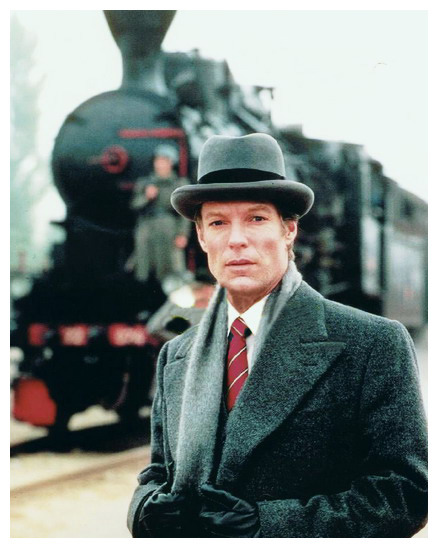
ALTERNATIVE STYLE ICON: RICHARD CHAMBERLAIN IN WALLENBERG: A HERO’S STORY
by Réginald-Jérôme de Mans
The writer George Santayana famously wrote that those who cannot remember the past are condemned to repeat it. Ironically many who repeat his quote forget who first uttered it.
I had long meant to write about Richard Chamberlain in this role. I once referred to him as “the fey king of the miniseries” and I don’t regret it: foppish, almost milquetoast in fare as varied as a two-part TV version of The Bourne Identity (with Jaclyn Smith, natch), Shogun, and as a leading candidate for an honorary Seinfeld puffy shirt: Not only did he play the Count of Monte Cristo in a 1975 TV movie, but a bunch of what Elaine Benes would have called chandelier-swinging characters in other Dumas adaptations, including Aramis in Richard Lester’s The Three Musketeers and Louis XIV and his twin in The Man in the Iron Mask. Postmodern swashbuckler author Arturo Perez-Reverte even described a character in one of his own novels as looking “like Richard Chamberlain in The Thorn Birds, only more manly.” That same Thorn Birds role, Father Ralph de Bricassart, also inspired a certain Rhunette Ferguson to give her son, a future New York Jets player, perhaps my favorite name ever: D’Brickashaw.
Dubbing Chamberlain an Alternative Style Icon for his role as Swedish diplomat Raoul Wallenberg is low-hanging fruit. For years this TV special dwelt at the bottom of my Netflix queue for that express purpose. Former Savile Row tailors Manning & Manning won an Emmy award for the outfits they made for him; decades later Bryan Manning had some very interesting things to say to the inimitable Simon Crompton of Permanent Style about the 1930s and 1940s cutting styles he had to adopt for Chamberlain’s outfits for the movie. Chamberlain’s costumes are appropriately dashing, from the full diplomatic gala white tie ensemble worn while conspiring with the Papal Nuncio of Budapest to a tan double-breasted suit with horizontal peaked lapels that is, quite simply, magnificent.
Zagreb, one of the most beautiful cities in eastern Europe, admirably filled in for 1940s Budapest and Stockholm in the making of this production. I’m fairly certain that I’ve stayed at the Zagreb hotel on whose esplanade Chamberlain wore that suit, in an early expository scene where the American and Swedish governments encourage Wallenberg to take a position with the Swedish legation in Budapest. I’ve been told Zagreb’s one of two cities in Europe where the street lamps in certain neighborhoods are still gaslit. Gaslighting happens to have been one of the reasons that I finally wrote about this icon.
Of course there’s plenty to mock in the conventions of this telefilm, even beyond Chamberlain’s indisputable 1970s and 1980s stock hero status: its heavy-handed setup and plotting, making Wallenberg out to be a one-man anti-Nazi force from his time at home in Sweden (wearing a U. Michigan sweatshirt to indicate that he had studied in the US - did college sweatshirts even exist back then?). Miniseries meant melodrama and its archetypal characters: an adorable child whom Wallenberg saves from the death camps only to die of illness; a shoehorned-in love interest in the form of a kindhearted baroness who lobbies her suspicious husband to relax the Hungarian government’s strictures on Jews; a fiery Hungarian resistance fighter who provides the unofficial, combative counterpoint to Wallenberg’s diplomatic, humanitarian efforts through official channels. And, of course, Wallenberg’s kidnapping by the Soviets at the fall of Budapest meant his story was perfectly framed for 1985, when we still couldn’t trust those Russians. (In fact, to this day no one knows what they did with him.)
A few appropriately haunting and powerful moments do ring true, including Wallenberg’s cordial verbal fencing matches over contraband Scotch and cigarettes with Adolf Eichmann. Whether those meetings really took place in that form or not, their film versions appropriately capture the realities of how we are forced to engage with evil. Rarely are we simply battling an easily identifiable other, weapon to weapon. Instead, we encounter evil in the everyday – in fact, it seeks us out, finds shared ground, converses with us over pleasantries and hospitality even as we recognize its intentions. It identifies with us, we identify with it. Even as you know it is evil.
Eichmann had made it his avowed duty to kill the Jews of Europe. Wallenberg’s mission, as an emissary of an officially neutral power, was to help save as many as he could. And he did, through famously fearless, reckless endeavors including the distribution of thousands of official-looking Swedish passes to the Jews of Budapest, the creation of vast cultural centers and warehouses in the Swedish mission buildings in which these new countrymen could work under the aegis of their adoptive country, and savvy diplomatic maneuvering with the Hungarian and German authorities and military. He went as far as to climb on top of a train bound for Auschwitz and distribute passes to as many deportees as he could while soldiers fired shots at him. Looking back, historians suggest they were firing over his head to warn him as they could easily have dropped him at that range, but it’s not likely Wallenberg knew that at the time.
At that time diplomats of neutral powers could make fortunes more safely as armchair heroes: playboy Porfirio Rubirosa reportedly did so in Paris selling visas to the Dominican Republic to French Jews during World War II. In that respect, perhaps, both he and Wallenberg were heroes… of different sorts.
Wallenberg did not do it for money. The Wallenbergs were Swedish aristocracy (with, the film takes pains to remind us, an ounce of Jewish blood) with considerable means – hence the finely tailored wardrobe for Chamberlain. Thus, an easy cynical response to this essay could be that a rich aristocrat with diplomatic immunity risked nothing swanning around the salons of Budapest, just like the fictional gentleman spies we read about and watch on screen.
That response is wrong. Heroism is not just born of opportunity. It is recognizing when a choice confronts you and taking the difficult, unpopular and dangerous one in order to do what is right. Fictional heroes like Bond or Steed rarely suffer meaningful personal loss and rarely confront the reality of evil. Evil is your friend with many positive qualities, maybe more intelligent or cultured or better dressed than you, the one you looked up to, who gradually reveals the awful things he or she believes and has done. Evil is those complicit in carrying out those things by their inaction, their credulity, or their cooperation, not at the point of a gun but of a paycheck. Evil is legal, logically explained, repeated and reported until its baseless reasoning becomes fact and the foundation for more lies, more evil. Evil can so easily become the system.
Hindsight is a handicap, for it doesn’t usually permit us to see that there were no times without ambiguity in battles between good and evil and no certainty that good triumphs. We have the privilege of retrospect to acknowledge the dashing diplomat in Savile Row suits was a hero for saving innocents from deportation and death as part of the most ghastly genocide in history. We learned what genocide is, and had to invent the word to describe it. Because at that time the people singled out for persecution and death were unpopular, historically, socially and legally marginalized, supposedly easily identifiable and classifiable. A group that societies had made it easy - through regulation, ghettoization, oppression and antagonism – to hate, and whole false narratives drawn up to explain why that group hated and wanted to destroy us even more than we them.
One of A Hero’s Story’s most timely and inspiring lines is Wallenberg’s reply to the Hungarian ruler’s query why the King of Sweden cared so much about the Jews of another country, when he was a Christian. Wallenberg reminded the prime minister that the King’s “concerns transcend religion or national borders.” That concern is humanity, our lowest common denominator, our shared recognition of our capacity for suffering. That concern drove a man to acts of incredible selflessness, a generous mercy that seems to have cost him his liberty and his life. There is no romance to Raoul Wallenberg’s fate. It is worth remembering that he probably saw little romance in the actions he took in Budapest.
Now is no less an unromantic time, no less a time when others – so many different others –are easily denigrated, feared, distrusted, brutalized. Otherization, both of many within our borders and pressing against them, has returned, as has fascism, with apologists blandly elegant or brutally populist, like some inauspicious comet in our skies. Now, again, is a time for heroes – men and women who recognize how difficult and dangerous it is to do what is right. That struggle is far from those of Chamberlain’s habitual roles swashbuckling against a monolithic, universally despicable, evil. Evil is among us, habituating us, desensitizing us, gaslighting us. Far from frills and fanfare, celebration, or certainty of triumph, can we place ourselves in Wallenberg’s Budapester shoes and do what is right?
Quality content, like quality clothing, ages well. This article first appeared on the No Man blog in February 2017.
13 notes
·
View notes
Text
“Stop Making Sense” (1984)
The basics: Wiki | IMDb | TVTropes
Opened: Jonathan Demme and David Byrne’s Talking Heads concert film opened the second week of March 1985. It ran for a few weeks, and by early June was showing at Village 8, the local second-run theater. It was revived at The Vogue in July, and ran a few times a month through 1986 and 1987, usually as the second-to-last or last show of the day.
Also on the bill: Opening weekend, it shared a very unlikely bill with the slow-burning 1975 Australian film Picnic at Hanging Rock. It also shared some more tonally appropriate bills with Buckaroo Banzai, Amadeus, Fellini Satyricon and another Australian cult favorite, Bliss. A few times, of course, it was inevitably programmed before the monthly midnight screening of Rocky Horror.
What did the paper say? Given its status in years since as the great rock concert movie of that (and any) era, there wasn’t much coverage at the time. The Courier-Journal’s regular film and theater critic from the late 1940s through the early 1990s, William Mootz, didn’t appear to see it. Janet Maslin’s glowing New York Times review was run instead, as was common practice for smaller movies. Vince Staten, the vaguely curmudgeonly but always insightful TV critic of the 1980s, wrote a few years later when it came out on VHS that "quite a few people, myself included, thought it was the best rock-concert movie ever made.” In 1987, towards the end of its run at The Vogue, a weekend roundup in the paper’s Saturday edition highlighted it, calling it "a cult in the making" that was “building a faithful following in its repeated engagements at the Vogue Theatre.” The headline was “’Stop Making Sense’ is making lots of cents.”
What was I doing? I was between six and eight years old. It was unrated, so I certainly could have seen it, though neither of my parents were Talking Heads fans, and I don’t think it would have occurred to them to take me -- this is the kind of thing my cool aunt would have considered taking me to see. Maybe I am giving myself more credit than I deserve, but I think I would have liked parts of it quite a lot.

In a mid-sized town like Louisville in the 1980s, I imagine fringe culture tended to consolidate itself into small, overlapping groups. Bookstores, bars, music venues, video stores, coffee shops and art galleries serving the same audiences all overlapped in their programming to some extent.
The Vogue, in addition to showing the movies we’re talking about here, was also an occasional music venue. Its musical programming served a roughly parallel function to its cinematic programming: it was an outlet what used to be called “alternative” culture. A number of Louisville’ earliest punk and new wave shows, in the late 1970s and early ‘80s, happened there.
In fact, on that note, I have an eBay alert set up for “vogue louisville” so I can grab any Vogue-related memorabilia that comes through. Almost nothing does, though recently there’s been someone trying to unload a ticket stub for an Iggy Pop show presented there in partnership with the Kentucky Center for the Arts in 1990. The sort of person who might go see Iggy would also likely be there for the showings that week, which included Pump Up the Volume and Pink Floyd The Wall. Neither of those were exactly countercultural circa 1990, but were certainly adjacent. (Incidentally, I’m a little tempted to buy that Iggy ticket, but it doesn’t even have the name of the Vogue printed on it, so it doesn’t seem like it’s really worth it for my purposes. Still, there it is below.)
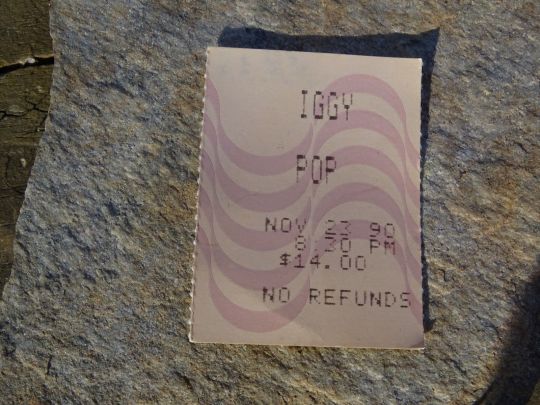
Jonathan Demme’s Stop Making Sense played the Vogue for about two years. Though that was a lot longer than most rock movies, it was far less than, for example, Led Zeppelin’s The Song Remains the Same, which played for ten years, or the aforementioned Pink Floyd The Wall, which showed regularly for almost fifteen, right up until a year before it closed. This tells us that while the Vogue catered regularly to a new wave crowd, their economic bread and butter was either aging boomers or stoned college kids who remained in an oblivious dope haze throughout the events of the 1980s (or possibly both).
But a few times a month for two years indicates there was a healthy interest in Stop Making Sense among a fairly sizable portion of Louisville’s young cultural elite. There were a lot of weirdo bands in Louisville in the mid-1980s, loosely aligned with punk but a little artier, and I wonder how of them were in attendance. Once again, this is one of the big problems with this experiment: watching a lot of these movies on a streaming service on a TV all by myself is so unlike seeing it projected on film in a communal setting with a roomful of people that it barely qualifies as the same experience. It’s like trying to write about having a dinner at the French Laundry by eating a Trader Joe’s frozen quiche lorraine over the sink in your kitchen. Koyaanisqatsi loses a lot in this format, and Stop Making Sense may lose even more.
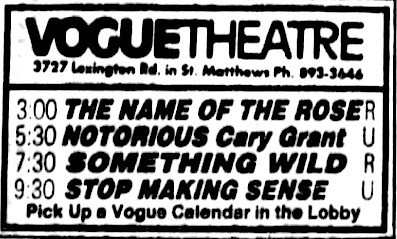
Koyaanisqatsi, which was also on the midnight movie circuit about the same time, is a fully immersive experience, like Stop Making Sense. Demme’s movie, though, goes a step beyond immersion by inviting active participation. It’s shot from the perspective of the audience, with no reaction shots or backstage interviews, and since the audio was recorded digitally, it was crystal-clear, or as crystal-clear as the P.A. allowed at the Vogue. Probably the sound and sights were, in some way, superior to those you might have seen at that Iggy Pop show live in person. Most of the reports from the time -- not in Louisville specifically, but in many places -- make note of people dancing in the aisles. I can imagine it must have been a similar scene at the Vogue.
As a director, I didn’t give any thought Jonathan Demme up until a few years ago. I’d seen Silence of the Lambs, and liked it OK, and although I adored Swimming to Cambodia, I thought that had more to do with Spalding Gray than Jonathan Demme. In a stirring reminder, though, that the internet can still cough up truly remarkable documents that change the way you see the world, I stumbled across this Jacob T. Swinney supercut from 2015. I remember opening it, and scoffing to myself, “oh, so Jonathan Demme is like an auteur now?”
Obviously I was way, way off-base. Three-and-a-half minutes later, the video had made a total convert of me. The way those faces looked at you -- clearly there was something here. I rented all of them over the course of a few weeks, through his early and middle period, from Melvin and Howard through Married to the Mob. I came away with the sensation of falling in love, partially with way of making movies but also with a whole worldview. Demme’s movies find a way to be incredible stylish assemblages of the best parts of North American culture (all accompanied by incredible soundtracks), and also turns its attention to oddballs, misfits and outcasts with a loving gaze that manages to be both amused and compassionate.
Stop Making Sense does all of these things. David Byrne is not warm, exactly, but his arch sense of humor is endearing, and of course he’s one of the great eccentrics of late 20th century American culture. And he’s surrounded by a gang of musicians that seem like they’re right of out of a Demme movie, like the house party at the end of Swing Shift or the Miami hotel pool in Married to the Mob: Chris Frantz in funny-dad mode with a very un-rock-star polo shirt, Bernie Worrell mugging at the camera, Tina Weymouth looking cool in a succession of power suits, Lynn Mabry and Ednah Holt providing synchronized commentary throughout.
It’s only at the end that Demme, as if he’s been teasing you by withholding them, allows some audience shots to sneak in. They look like the sorts of sweet, goony people you’d hope to meet at a Talking Heads show. After every Demme movie, there’s a sense that you, too, could be part of a global community of weirdos who take care of one another.
I can tell you from experience that being weird in a place like Louisville, a town that can be both rigidly conservative and indulgent of eccentricity, could be sort of a lonely experience. It was also the sort of place where there were enough of you out there that you usually found each other somehow. I hope a few of the members of that Demmian-Byrnian community, all out at the Vogue on a Saturday night dancing in the aisles, caught a glimpse of one another when the lights came on.
1 note
·
View note
Text
The Little Mermaid: Alex’s Feminist Crisis
I've been waiting for this day to come, because finally I get to watch My Favorite Movie of All Time:

Clearly we are talking about The Little Mermaid. I'm sure this is going to be a rather difficult one to deal with because this is a film that is often criticized for a not-great portrayal of a female; in fact Ariel is considered by many to be the Worst Princess. Yet, by others, she is still beloved by many. See, Ariel is, to me, Marmite Princess. You either love her spunk, her curiosity, her determination, maybe her red hair; or you hate that she fell in love with a man she knew for a minute, gave up everything she knew (and everything that made her special) to be with him, and was kind of a brat to her dad. These are all very valid reasons to like or dislike Ariel! It's a film that warrants about as much praise as it does criticism (again, Snow White, in my opinion, has more issues than most princess films). So this is probably a good time to weigh those pros and cons. Hold on to your dinglehoppers and get your snarfblats, because we're heading out to Atlantica for a spell.

The Little Mermaid is Disney’s adaptation of a Hans Christian Andersen classic about a young mermaid, curious about the world above the sea. In this adaptation, the mermaid is a called Ariel, and she is the youngest (and most rebellious) of seven sisters, who all awkwardly 1. look nothing like her and 2. all have names starting with A. She likes to spend a lot of time going to the surface to show all her weird human stuff (she’s a hoarder with a huuuuge collection of it--she puts most comic book collectors to shame) to her seagull friend, Scuttle. This really displeases her racist anti-human dad, King Triton, who continually forbids her from going to the surface. One night she goes against her father’s wishes and watches a ship above, as they hold a big birthday party for a dashing prince named Eric. Ariel is enamored with Eric. Like, full-on heart eyes. He’s a living Tiger Beat centerfold, John Stamos circa 1989 was shaking (John Stamos circa 2017 just kinda became him). Suddenly a storm arrives, the ship goes down, but Ariel saves Eric. When Ariel returns home, she is hopelessly in love, which leaves daddy curious, but changes his tune when he finds out it’s a human his daughter is in love with. He destroys Ariel’s hoard grotto, leaving her in tears. She is then lured by a pair of eels with a deal--we know someone who can give you what you want. They lead her to Plus Size Icon, Ursula, a caecilian sea witch. She offers to give Ariel legs for three days, in exchange for her flawless singing voice, and if she can kiss the prince before the three days are up, she can keep the legs, but if not, she goes back to Fintown. Ariel obliges, and spends some largely non-verbal time with her prince, him completely unaware that she is the mystery woman who saved his life. When Ariel comes too close to her kiss, Ursula intervenes, disguised as Eric’s mystery savior, and puts him in a trance that leaves Ariel completely hopeless. After her friends intervene and restore her voice, Ursula takes the now-mermaid-again Ariel back to the sea to fight for her father’s freedom, because SURPRISE! she’s got him now, too. With Eric’s help, the evil is defeated, Triton relents, allows Ariel her legs back, and her prince, Happily Ever After, yadda yadda yadda.
WHEW. You can tell I’ve seen this...more than a few times.
The Little Mermaid comes at a pivotal time in the company. Not because it’s the first time Disney has made a Princess film since 1959, but because...well, at this point, things are Not Great at the company. We are coming out of what is called the Dark Age of Disney, where its films are just not going great. The Black Cauldron is a critical and commercial bomb, and The Great Mouse Detective and Oliver and Company didn’t go so great either. Basically, Disney is banking on Ariel to rejuvenate the company. Ultimately, she does, and the Disney Renaissance begins. Because my mom remembers 1989 better than I do (I was born November of the following year), she says that Ariel was kind of like the Elsa of her time. Everyone wanted to be Ariel. In 2018, everyone still wants to be Ariel, as grown-ass women claim to be mermaids. Including myself. Yes, I am calling myself out. But this is just the impact Ariel has had on women of all ages. In fact, Ariel is the most famous portrayal of a mermaid of all time (a fact I mentioned to Jodi Benson herself /humblebrag). For more on this, please watch the Little Mermaid documentary, Treasures Untold. (I can’t remember if this is the one that accompanies the 2006 Platinum Edition release of the film, but it’s eye-opening regardless.)

Let's begin with the pros.
-ERIC WAS NOT THE REASON ARIEL WENT TO THE SURFACE. I REPEAT, ERIC WAS NOT WHY ARIEL WANTED TO BECOME HUMAN. This is a common misconception for anyone who apparently missed the entire "Part of Your World" number. Clearly, Ariel had a fascination with the human world before ever setting sights on Eric, in fact, if she wasn't so keen to explore the surface, she probably would have never even seen him. She needed a motivation to get up there, and to paraphrase another sea-based Princess, the call wasn't out there at all--it was inside her. If anything, Eric was more of a final straw. Also, if Flotsam and Jetsam hadn't intervened, she probably would not have taken such drastic action. Ariel didn't just cry because Triton destroyed her statue of her crush. Keep in mind he destroyed the ENTIRE grotto. All of Ariel's gadgets, gizmos, whosits, whatsits, thingamabobs, dinglehoppers, snarfblats, you name it--all up in smoke. Stuff she probably spent YEARS collecting. I know I'd be pissed if someone wrecked my Sailor Moon collection. (Also it probably meant that Triton would have an even closer eye on her so it was definitely all over for her--I'd cry, too.)

-In the original Little Mermaid tale, when the mermaid gains her legs, walking is incredibly painful for her. Whenever she walks, she feels the sensation of walking on knives. Ariel, seemingly, does not. I am 100% okay with this. Also, when the mermaid does not get her prince, her sisters cut their hair off and give to the sea witch in exchange for a knife. With the knife, the mermaid is supposed to stab the prince, have his blood pour over her feet, and that will make her a mermaid again. She refuses, because she's not so jealous she would kill over it. Instead, she flings the knife out to sea, throws herself onto the water, and dissolves into seafoam. Whether this is good or bad probably depends on how much of a purist you are for the original, or how much you like despair porn. Personally I don't think the wages of Ariel's (admittedly, crappy) decision should be death, so this is fine by me. Sure, a generic Happy Ending is kind of a cop-out, and it would have been interesting for Disney to play it closer to the original, but Disney won't simply kill off a Princess. Come on, now.
-Animation-wise, this is probably one of Disney's best. This is one of the last of its kind, being 100% hand-drawn. They would revisit this style with The Princess and the Frog and later Winnie the Pooh (2011, not the Many Adventures), but not since Pooh, since I guess CGI is more profitable. Go figure.
-This film also boasts some of Disney's best songs and best score. This is the first film in which Disney worked with the power duo of Alan Menken and Howard Ashman. This tradition would continue until Aladdin (Ashman passed away shortly before the release of Beauty and the Beast, but still had songs featured in Aladdin). The only better Disney songwriting duo, in my opinion, might be Robert Lopez and Kristen Anderson-Lopez (Frozen, Coco). But we do not meet them for a whiiiiile.
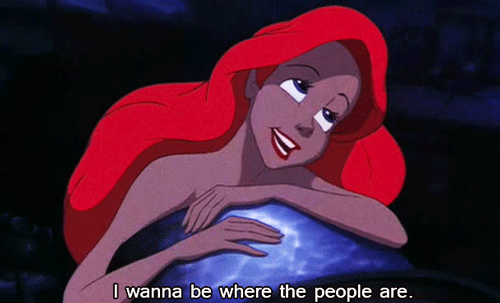
-Ariel oozes personality compared to a few of the other princesses we have met so far. She is motivated, knows what she wants, is fearless, and delightfully curious. This also is her biggest downfall, but we'll get into that in a second.
-Ursula, too, is a GREAT example of a villain. Like with Maleficent in Sleeping Beauty, her beef is not with our title princess, but with her father, and she uses our princess as more of a pawn in her plan (so, nothing personal). So the woman vs woman issue in Snow White (and later Tangled) is not present here, though it might look like that on the surface. Also, it's been pointed out that Ursula can shapeshift, but prefers to take the form of a plus-sized caecilian sea witch. Basically, she's fat-positive! See, even the villain is progressive. Well, kinda.
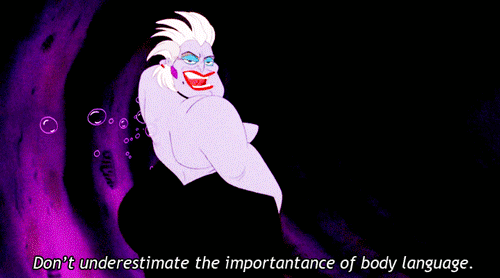
-Vanessa (Ursula’s alter ego) is hot. There, I said it.
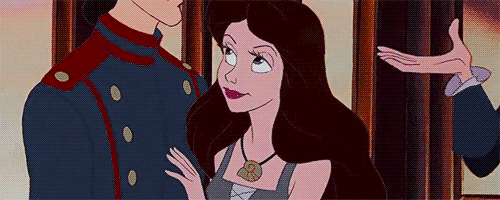
Do I really need to go into the cons? ...Ugh, it really pains me to criticize this film so heavily.
-It is troublesome that Ariel gave up everything she had for a dude who she barely knew, admittedly. While I insist that Eric was not her sole intention, still, him being the sort of bait (again, remember Flotsam and Jetsam's role in this) and Ariel taking it are all...dodgy.

-Ariel's greatest strength is also her greatest downfall. Her curiosity leads her to a sunken ship and to the surface, thus defying her father (and the iconic "I'm sixteen, I'm not a child" line) and Sebastian in the process. This, obviously, is...not true. Unless this film takes place in Scotland, where 16 is the age of majority (what up Merida), or one of a few African countries (such as Cameroon and Niger), who define the age of majority as early as 15. Which brings me to...
-WHERE ON EARTH DOES THIS FILM TAKE PLACE? For most Princess films, its location is pretty cut and dry. Snow White seems very German. Cinderella, possibly French? Brave obviously takes place in Scotland, Mulan in China, and Pocahontas and The Princess and the Frog in different areas of the North American continent. But The Little Mermaid is an anomaly. Most people just claim Denmark because of the nationality of Hans Christian Andersen (as well as the iconic Little Mermaid statue in Copenhagen), but by that logic, you could claim the same for Frozen, however, Frozen takes place in a fictional Norwegian kingdom, not in Denmark. The wildly colorful sea life lends itself to a possible Caribbean setting, Denmark still checks out for the human world. But who even knows, really.
-A few racist caricatures in “Under the Sea”: The “fluke, the duke of soul,” the “blackfish” (who sings), and the Carmen Miranda fish that grabs Flounder out of the blue. I’m under the impression that the “blackfish” was supposed to be an homage to Ella Fitzgerald...but it just comes off wrong.
-I wish we could have had more opportunities to see Ariel conversing with her sisters. She has six of them, there's really no excuse, unless she is purposely distancing herself from them? But like, geez, what would be the beef? Did Attina place her crown on Ariel's vanity seat for her to sit on?
-Can Ariel write basic English? Just out of curiosity.
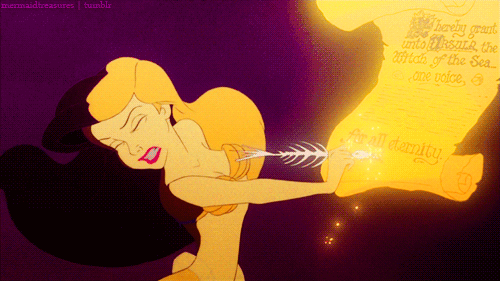
I do have one complaint that The Little Mermaid kind of set this pattern of mermaid movies being kind of samey, where the mermaid has to become human in order to chase after a man or something of that nature (I love Splash, but that’s one of those films). However, if you're looking for some new kind of mermaid flavor, I might recommend The Mermaid by Stephen Chow (if you can find it subtitled, it's in Chinese), or Freeform's Siren series.
Final thoughts: If you love something, you really have to be honest about it. In my case, I know where the issues lie with The Little Mermaid, and I admit them--begrudgingly. As with many Princesses, Ariel is not without her misconceptions, yet also not without valid criticisms. Ariel's message, on the surface, is that men are to be desired and women should chase after them. But in order to really understand Ariel, you have to dive a bit deeper: If you want something, go for it, rather than wishing and wishing.
Rating: 5 out of 5 dinglehoppers
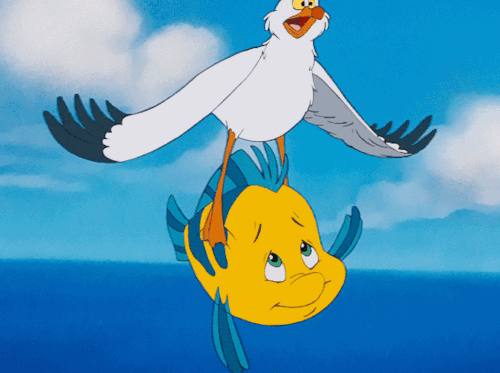
Thanks for joining me for this (admittedly, difficult) party. Join me for my next one where we look into the misconceptions and misogynists of Beauty and the Beast. No, not that one. Dream Big, Princess!
#disney#disney princess#the little mermaid#in which alex is salty#get it bc mermaids live in the ocean and the ocean is salty#mermaid vibes#mermaid hair don't care#i'm done adulting let's be mermaids#just thinking of quirky mermaid shirts i've seen on etsy...
1 note
·
View note